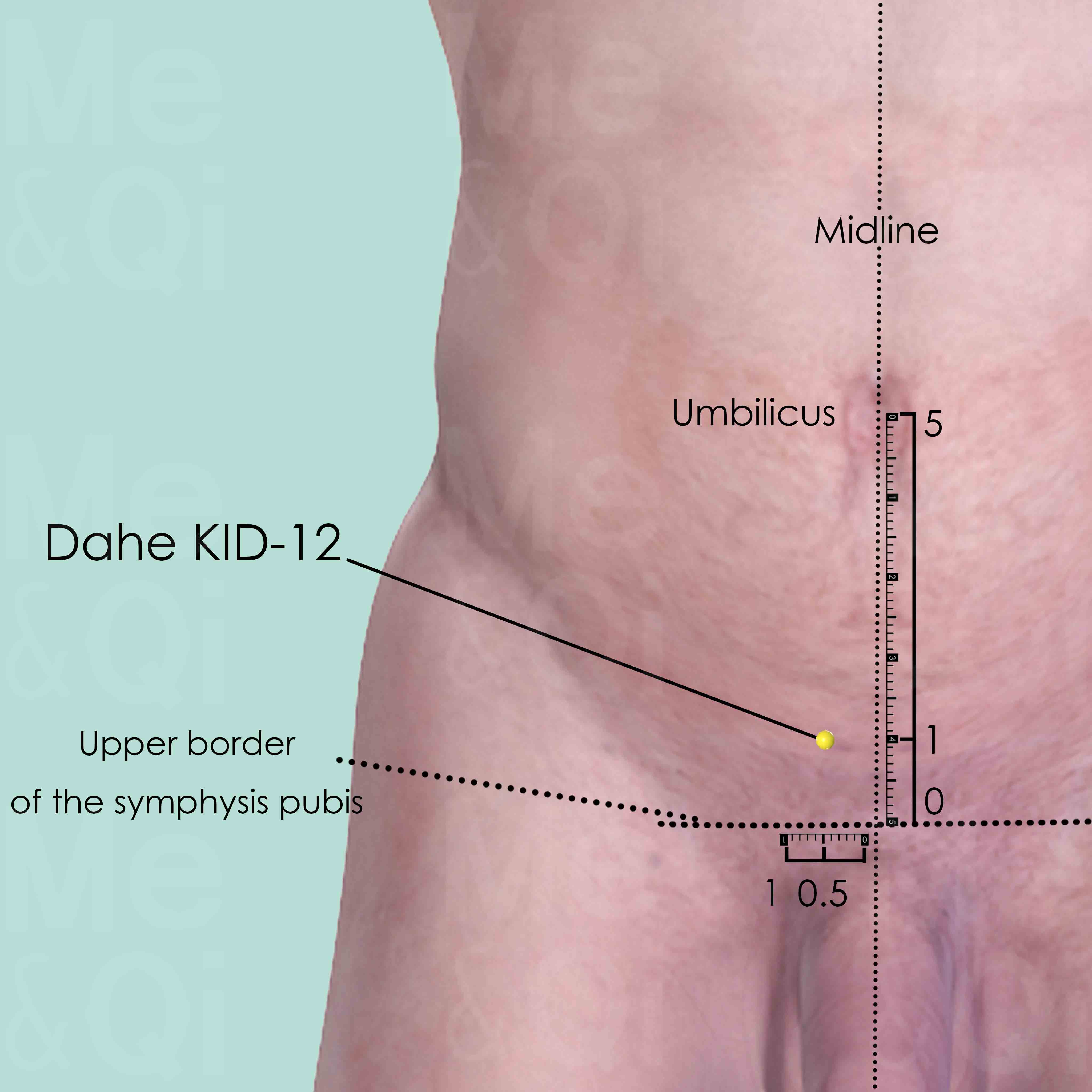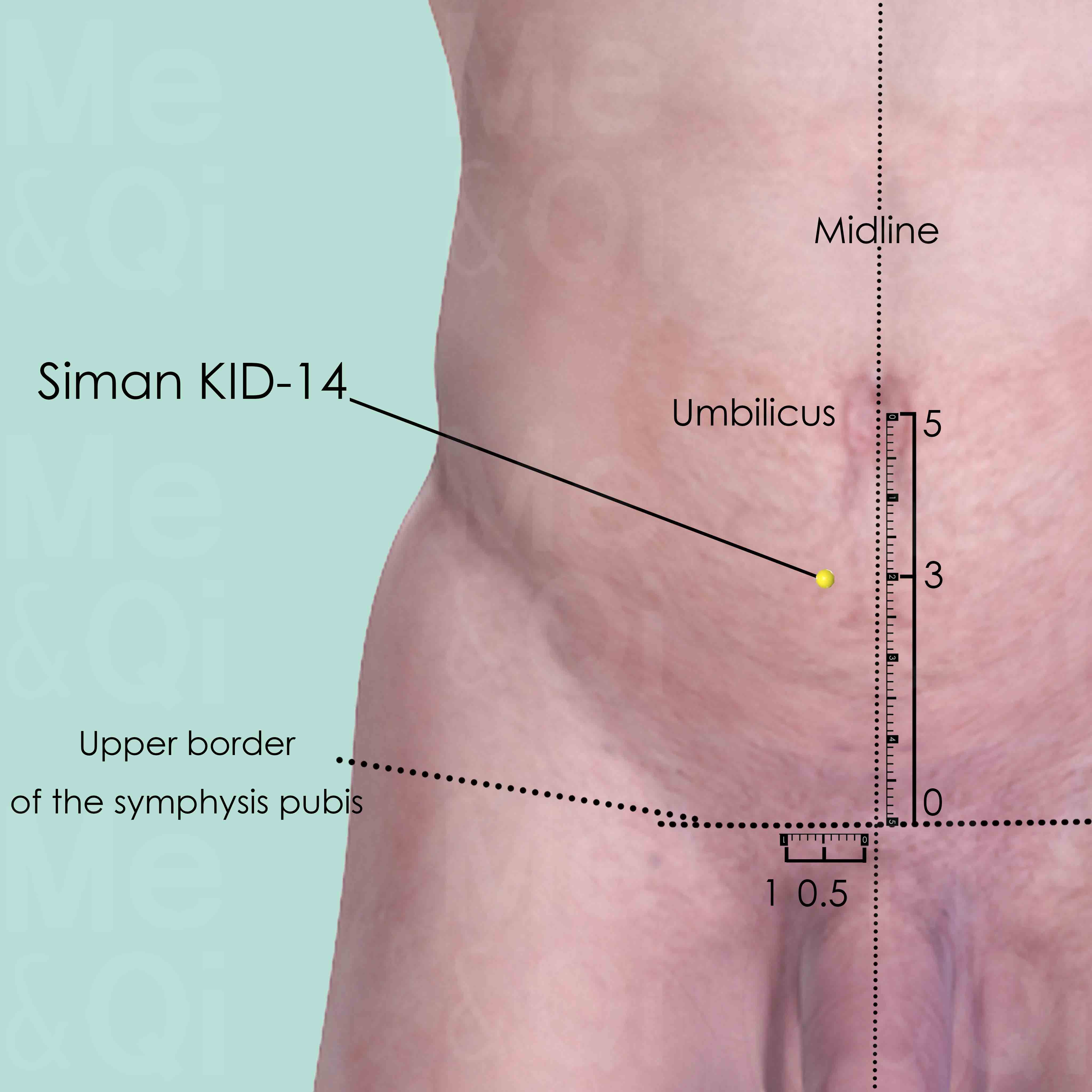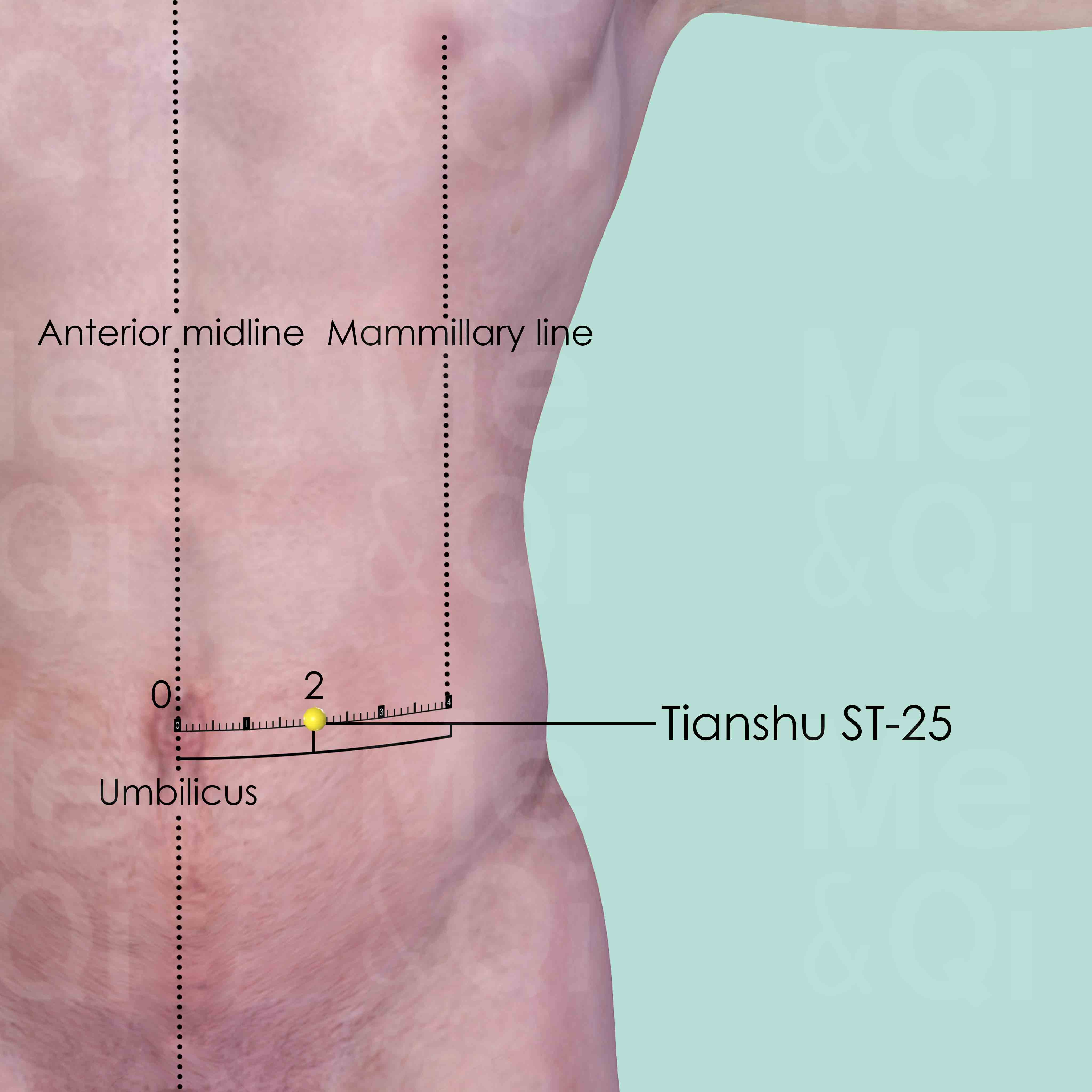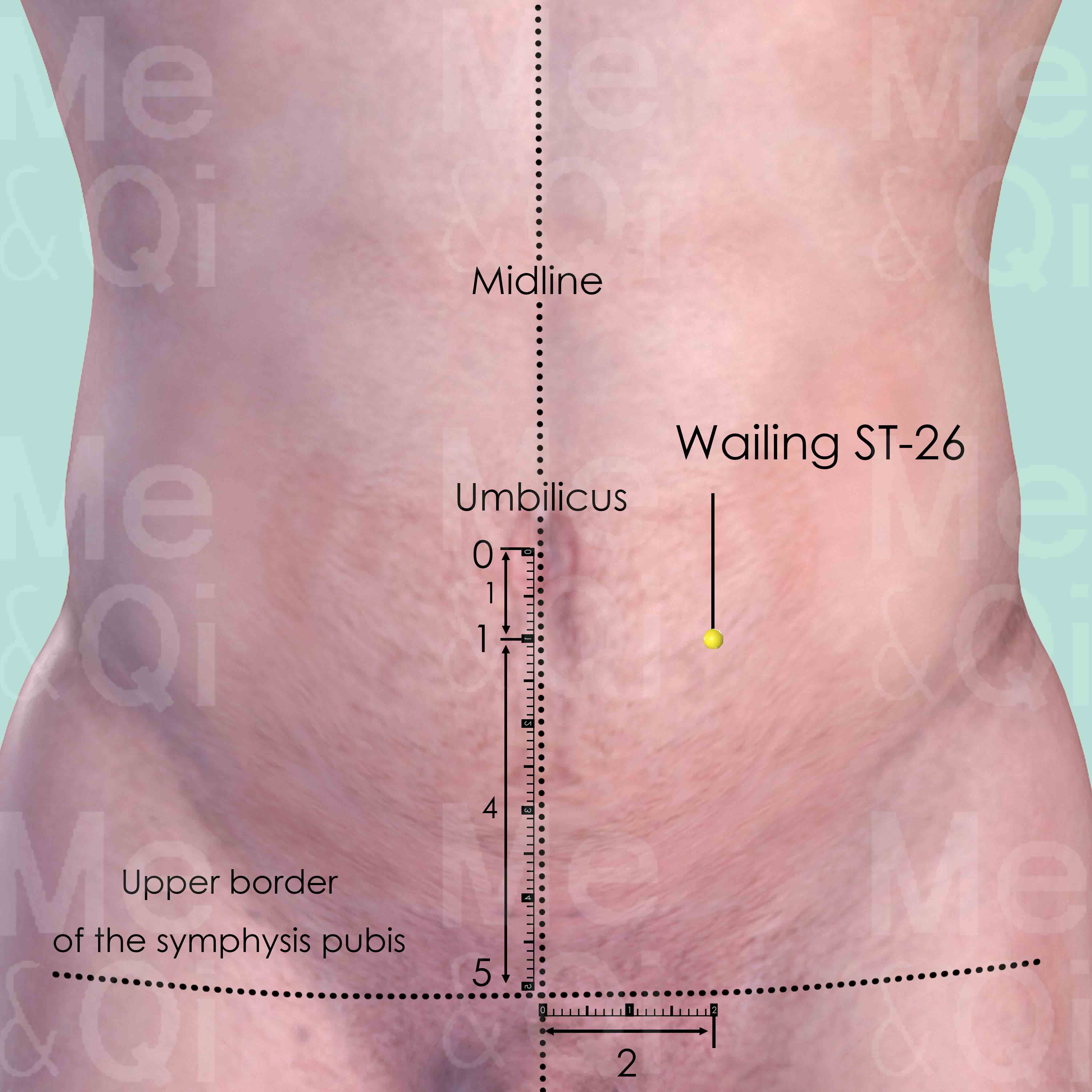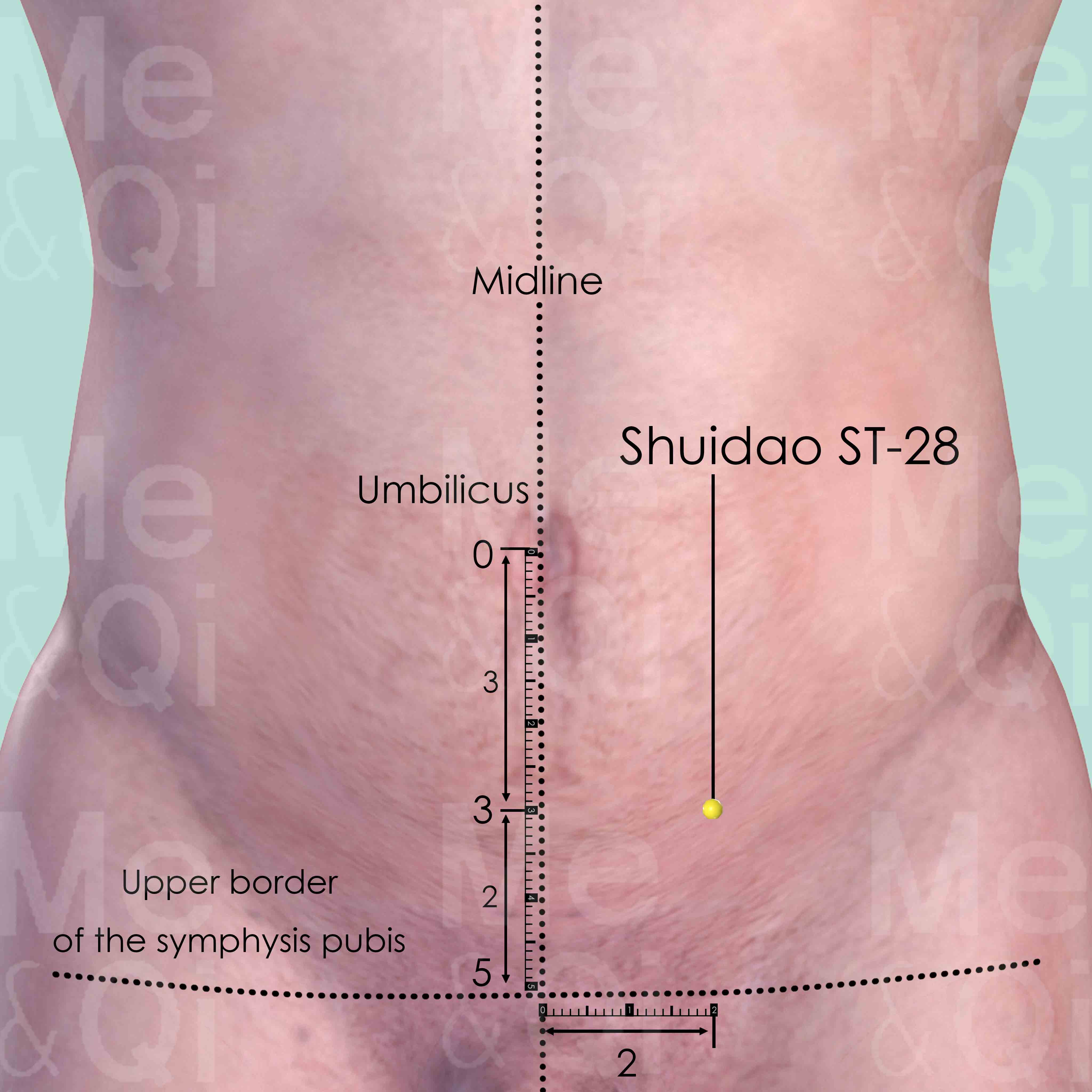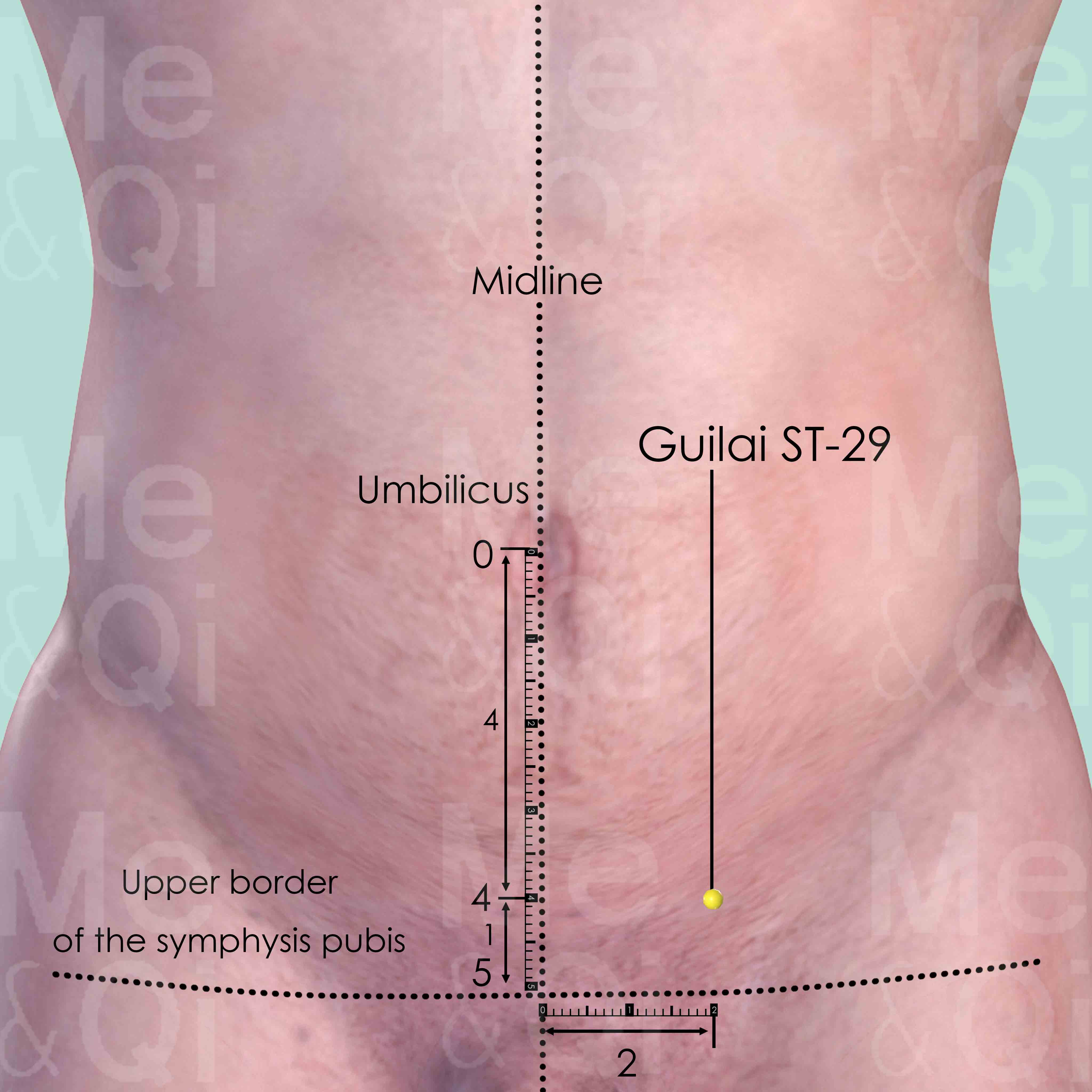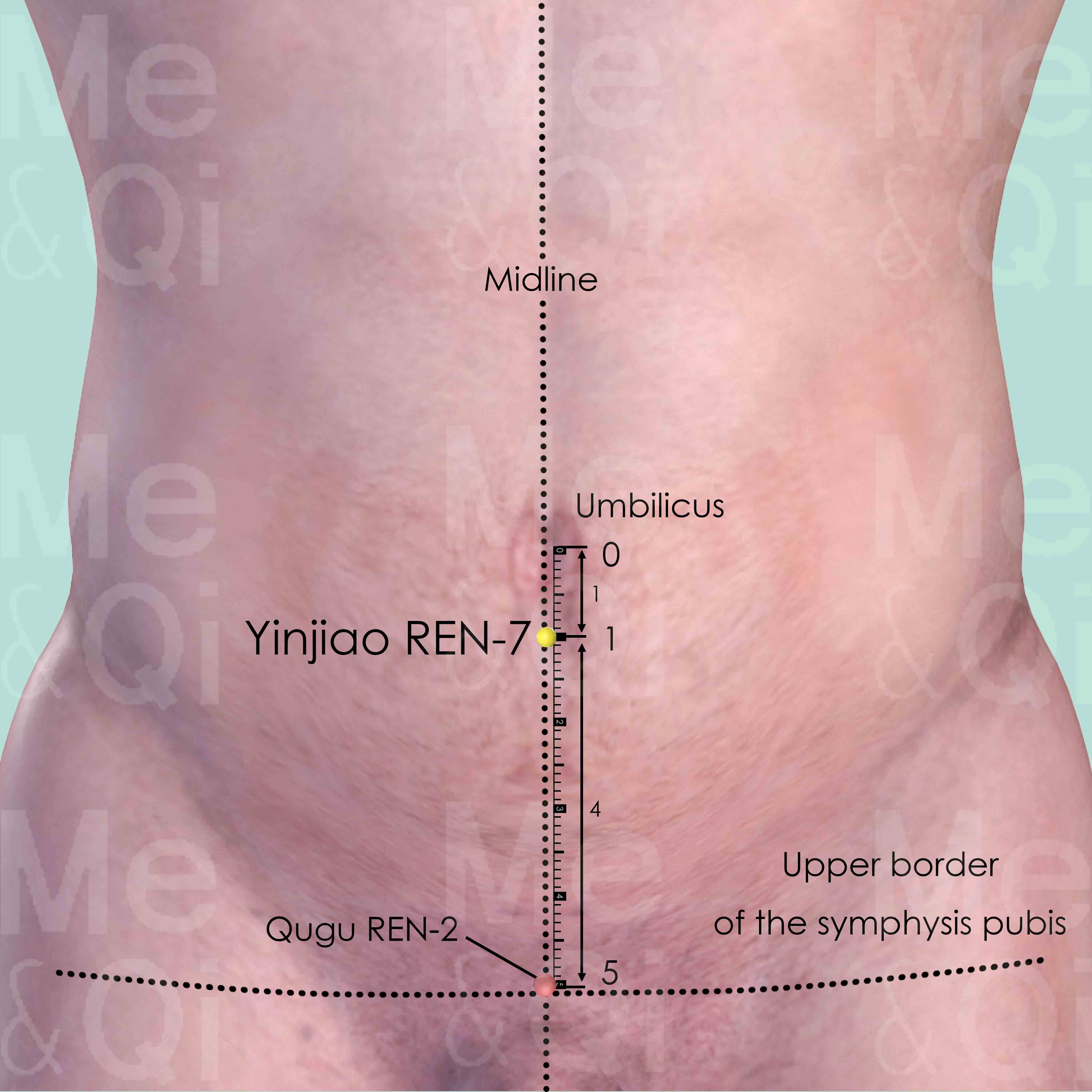Menstrual Crampsaccording to TCM
What is Menstrual Cramps?
Menstrual cramps, medically termed as dysmenorrhea, are painful sensations experienced in the lower abdomen before or during menstrual periods. These cramps are characterized by a throbbing or cramping pain, ranging from mild to severe, and can sometimes extend to the lower back and thighs. For some women, menstrual cramps are merely a monthly discomfort, while for others, they can be debilitating, affecting daily activities. Understanding the nature and severity of menstrual cramps is crucial for effective management and treatment.
How Does TCM View Menstrual Cramps?
Traditional Chinese Medicine (TCM) interprets menstrual cramps as an indication of disharmony within the body's internal systems. Contrasting with the more symptom-focused approach of Western medicine, TCM views these cramps as a manifestation of imbalances in the flow of Qi (vital energy) and Blood, particularly involving the Liver and Uterus.
TCM emphasizes diagnosing and treating the specific pattern of disharmony causing the cramps, thereby addressing both the symptoms and their underlying causes. This holistic approach considers the entire individual, including emotional and physical health.
Root Causes of Menstrual Cramps in TCM
In TCM, menstrual cramps can result from various patterns of disharmony. One common cause is Blood Stagnation, where the flow of Blood is obstructed, leading to painful menstruation. This condition is often characterized by symptoms like fixed stabbing pain, dark menstrual blood with clots, and mood swings.
Another cause is Qi Stagnation, typically resulting from emotional stress, which can manifest as cramps accompanied by chest distension and irritability. These patterns reflect the importance of the smooth flow of Qi and Blood in preventing and alleviating menstrual cramps.
Another key cause of menstrual cramps in TCM is the presence of Cold in the Uterus. This occurs when cold energy disrupts the reproductive system, causing blood vessel constriction and hampering Qi and Blood flow. Symptoms include cramps alleviated by heat, delayed periods with dark clots, and a preference for warmth.
Explore below more details about what might cause Menstrual cramps according to TCM.
- By Syndrome
- By Organ
- Blood Stasis
- Qi Stagnation
- Heat
- Cold
- Dampness
- Qi Deficiency
- Blood Deficiency
- Phlegm
- View More Causes
- Liver
- Uterus
- Pericardium
Blood Stasis
Blood Stasis in TCM is a concept where the blood flow in the body is not as smooth or efficient as it should be. Imagine a river that's supposed to flow freely, but instead, it's getting blocked or moving too slowly in some parts. This can lead to various health issues, like pain that feels sharp or stabbing, dark bruises, and a complexion that looks purplish. TCM believes that good health relies on the smooth and vibrant flow of Qi and blood throughout the body, so when blood gets stuck, it's like a traffic jam in your body, leading to discomfort or health problems.... see more
Blood Stasis Patterns That Can Lead to Menstrual Cramps
Common Symptoms: Dark Menstrual Clots Abdominal Masses Irregular Periods Purple Lips Purple Nails Amenorrhea Dark Menstrual Blood Abdominal Pain
| Pattern Name | Relevant Symptoms | Relevant Formulas |
|---|---|---|
| Qi And Blood Stagnation | dysmenorrhea, dysmenorrhoea, menstrual cramps, painful periods, Painful period, Intense period pain, Chest distension, Chest pain, Stabbing fixed pain, Dark face, Purple lips, Purple nails, Irritability, Mood swings, Depression, Mottled skin, Foot edema, Abdominal masses, Melena black tarry stool, Amenorrhea, Dark menstrual clots, Dark menstrual blood, Prolonged lochia, Irregular periods... see more | Xiao Yao San | Tao Hong Si Wu Tang | Ge Xia Zhu Yu Tang | Shao Fu Zhu Yu Tang | Chai Hu Shu Gan San | Dan Shen Yin | Shi Xiao San | Xue Fu Zhu Yu Tang | Shen Tong Zhu Yu Tang | Qi Li San | Guo Qi Yin |
| Blood Stagnation | Painful period, Premenstrual pain, Dark face, Purple lips, Stabbing fixed pain, Abdominal masses, Purple nails, Menstrual cramps, Dark menstrual clots, Dark menstrual blood, Lumps... see more | Tao Hong Si Wu Tang | Ge Xia Zhu Yu Tang | Shao Fu Zhu Yu Tang | Si Wu Tang | Tao He Cheng Qi Tang | Da Huang Mu Dan Pi Tang | Gui Zhi Fu Ling Wan | Di Dang Tang | Dan Shen Yin | Da Huang Zhe Chong Wan | San Zhong Kui Jian Tang | Hai Tong Pi Tang | Huang Qi Gui Zhi Wu Wu Tang | Shi Xiao San |
| Liver Blood Stagnation | Painful period, Hypochondriac pain, Abdominal pain, Vomiting blood, Nosebleeds, Menstrual cramps, Irregular periods, Dark menstrual clots, Infertility, Abdominal masses, Purple nails, Purple lips, Purple face, Skin dryness, Petechiae... see more | Xiao Yao San | Ge Xia Zhu Yu Tang | Chai Hu Shu Gan San | Shi Xiao San |
| Pericardium Blood Stagnation | Painful period, Palpitations, Chest pain, Chest distension, Stifling sensation in the chest, Shortness of breath, Purple lips, Purple nails, Menstrual cramps, Dark menstrual clots... see more | Xue Fu Zhu Yu Tang |
| Blood Stagnation and Phlegm in the Uterus | Painful period, Persistent uterine bleeding of purple or dark blood, Lower abdominal distension and pain that increases with pressure, Lower abdominal fibroids and cysts, Menstrual cramps, Irregular periods, Abdominal pain, Prolonged lochia, Infertility, Postpartum hemorrhage, Retained placenta... see more | Gui Zhi Fu Ling Wan |
| Blood Stagnation in the Directing and Penetrating Vessels | Painful period, Irregular periods, Brown vaginal discharge, Dark menstrual clots, Menstrual cramps, Dark menstrual blood, Prolonged lochia, Lower abdominal pain, Umbilical pain, Breast engorgement, Breast pain... see more | Gui Zhi Fu Ling Wan |
| Blood Stagnation in the Lower Burner caused by Cold | Painful period, Abdominal masses, Lower abdominal pain, Lower abdominal distension, Lower back pain, Abnormal uterine bleeding, Menstrual cramps, Dark menstrual clots... see more | Shao Fu Zhu Yu Tang |
Qi Stagnation
Qi Stagnation in TCM is like having a traffic jam in your body's energy system. Qi, the vital life force that flows through your body, is supposed to move smoothly to maintain health and balance. But with Qi Stagnation, this flow gets blocked or slowed down, like cars stuck on a highway. This can lead to symptoms like feeling stressed, emotional mood swings, and physical discomfort, often described as a feeling of fullness or tightness, especially in the chest or abdomen. It's as though the body's internal energy circulation is disrupted, causing various issues. TCM sees this as an energy flow problem, different from modern medicine's focus on specific physiological processes.... see more
Qi Stagnation Patterns That Can Lead to Menstrual Cramps
Common Symptoms: Irritability Depression Mood Swings Pre Menstrual Tension Irregular Periods Dark Menstrual Blood Abdominal Pain Breast Engorgement
| Pattern Name | Relevant Symptoms | Relevant Formulas |
|---|---|---|
| Stagnant Liver Qi turning into Fire | Menstrual cramps, dysmenorrhea, dysmenorrhoea, painful periods, Hypochondriac distention, Upper abdominal distension, Feeling of oppression of the chest, Irritability, Melancholia, Depression, Mood swings, Globus sensation, Feeling hot, Flushed face, Thirst, Anger, Pre menstrual tension, Irregular periods, Pre menstrual breast distension, Excessive menstruation... see more | Xuan Yu Tong Jing Tang | Jia Wei Xiao Yao San | Dan Zhi Xiao Yao San |
| Qi And Blood Stagnation | dysmenorrhea, dysmenorrhoea, menstrual cramps, painful periods, Painful period, Intense period pain, Chest distension, Chest pain, Stabbing fixed pain, Dark face, Purple lips, Purple nails, Irritability, Mood swings, Depression, Mottled skin, Foot edema, Abdominal masses, Melena black tarry stool, Amenorrhea, Dark menstrual clots, Dark menstrual blood, Prolonged lochia, Irregular periods... see more | Xiao Yao San | Tao Hong Si Wu Tang | Ge Xia Zhu Yu Tang | Shao Fu Zhu Yu Tang | Chai Hu Shu Gan San | Dan Shen Yin | Shi Xiao San | Xue Fu Zhu Yu Tang | Shen Tong Zhu Yu Tang | Qi Li San | Guo Qi Yin |
| Liver Qi Stagnation | Menstrual cramps, Hypochondriac distention, Chest distension, Upper abdominal distension, Abdominal distention, Sighing, Melancholia, Depression, Mood swings, Irregular periods, Globus sensation, Pre menstrual breast distension, Pre menstrual tension, Anxiety, Anger... see more | Jia Wei Xiao Yao San | Xiao Yao San | Yue Ju Wan | Chai Hu Shu Gan San | Yi Guan Jian |
| Liver Qi Stagnation that transforms into Heat | Painful periods that get worse with hot food or drinks, Intermittent upper abdominal pain, Hernia-Related pain, Dysmenorrhea exacerbated by hot food or drinks, Irritability, Bitter taste in the mouth, Peptic ulcer, Chronic gastritis, Hepatitis, Cholecystitis... see more | Jin Ling Zi San |
Heat
In TCM "Heat" signifies an excess of Yang energy, leading to an imbalance where heat predominates over the body's cool Yin aspects. This condition is metaphorically akin to an internal over-heating. Symptoms indicative of Heat can include feelings of warmth, fever, sweating, irritability, red face, thirst with a preference for cold drinks, and a rapid pulse. The tongue may appear red with a yellow coating. Unlike the common interpretation of heat in terms of temperature, in TCM, it represents a state of hyperactivity or inflammation in the body.... see more
Heat Patterns That Can Lead to Menstrual Cramps
Common Symptoms: Bitter Taste In The Mouth Irregular Periods Irritability Feeling Hot Thirst Excessive Menstruation Scanty And Dark Urine Sore And Weak Limbs
| Pattern Name | Relevant Symptoms | Relevant Formulas |
|---|---|---|
| Stagnant Liver Qi turning into Fire | Menstrual cramps, dysmenorrhea, dysmenorrhoea, painful periods, Hypochondriac distention, Upper abdominal distension, Feeling of oppression of the chest, Irritability, Melancholia, Depression, Mood swings, Globus sensation, Feeling hot, Flushed face, Thirst, Anger, Pre menstrual tension, Irregular periods, Pre menstrual breast distension, Excessive menstruation... see more | Xuan Yu Tong Jing Tang | Jia Wei Xiao Yao San | Dan Zhi Xiao Yao San |
| Damp-Heat | dysmenorrhea, dysmenorrhoea, menstrual cramps, painful periods, Fever, Neck gland swelling, Headaches, Tight feeling in chest and stomach, Sticky taste in the mouth, Absence of thirst, Feeling hot, Feeling of heaviness, Bitter taste in the mouth, Acne... see more | Xiao Yao San | Er Miao San | Qing Re Tiao Xue Tang |
| Damp-Heat in the Liver | Menstrual cramps, Hypochondrial fullness with warmth relief, Abdominal fullness, Lower abdominal fullness, Bitter taste in the mouth, Sticky taste in the mouth, Lack of appetite, Nausea, Feeling of heaviness, Yellow vaginal discharge, Vaginal itching, Vulvar eczema, Vulvar sores, Bleeding between periods, Midcycle bleeding pain, Red and swollen scrotum, Red and swelling genital, Papules, Itchy vesicular rashes, Urinary dysfunction, Urinary burning, Dark urine... see more | Long Dan Xie Gan Tang | Yin Chen Hao Tang |
| Liver Qi Stagnation that transforms into Heat | Painful periods that get worse with hot food or drinks, Intermittent upper abdominal pain, Hernia-Related pain, Dysmenorrhea exacerbated by hot food or drinks, Irritability, Bitter taste in the mouth, Peptic ulcer, Chronic gastritis, Hepatitis, Cholecystitis... see more | Jin Ling Zi San |
Cold
In TCM "Cold" as a pattern of disharmony refers to a specific type of imbalance within the body's systems, often linked to a deficiency or weakness. It's not about feeling physically cold or having a common cold, but rather a metaphorical description of certain symptoms and underlying conditions. When a TCM practitioner says someone suffers from "Cold," it usually implies that the body's Yang energy, which is warm and active, is insufficient or overpowered by Yin energy, which is cool and passive. Symptoms of Cold in TCM can include a general feeling of coldness, cold limbs, pale complexion, low energy, slow metabolism, and a preference for warmth. ... see more
Cold Patterns That Can Lead to Menstrual Cramps
Common Symptoms: Dark Menstrual Clots Diarrhea Lack Of Appetite Infertility Scanty Menstruation Late Menstruation Chills Cold Extremities
| Pattern Name | Relevant Symptoms | Relevant Formulas |
|---|---|---|
| Cold in the Uterus | dysmenorrhea, dysmenorrhoea, menstrual cramps, painful periods, Painful period, Diarrhea, Lack of appetite, Generalized fatigue, General weakness, Thin vaginal discharge... see more | Wen Jing Tang | Shao Fu Zhu Yu Tang | Wen Qi Hua Shi Tang | Si Wu Tang | Da Ying Jian |
| Empty-Cold | Painful period, Chills, Cold extremities, Pale face, Absence of thirst, Low energy, Perspiration, Diarrhea, Clear urination, Frequent urination... see more | Huang Qi Jian Zhong Tang | Da Jian Zhong Tang |
| Blood Stagnation in the Lower Burner caused by Cold | Painful period, Abdominal masses, Lower abdominal pain, Lower abdominal distension, Lower back pain, Abnormal uterine bleeding, Menstrual cramps, Dark menstrual clots... see more | Shao Fu Zhu Yu Tang |
| Full Cold in the Directing and Penetraing Vessels | Painful period, Menstrual cramps, Cold sensation in lower abdomen, Infertility, Late menstruation, Dark menstrual clots, Postpartum abdominal pain, Abnormal uterine bleeding, Uterine hypoplasia, Endometrial hyperplasia, Endometriosis... see more | Wen Jing Tang |
Dampness
"Dampness" in TCM is a concept that describes a pattern of disharmony where the body accumulates excess moisture. Imagine the heavy, sticky feeling you get on a very humid day; that's similar to what dampness feels like internally. It can manifest as a sense of heaviness, bloating, sluggishness, or even a foggy mind. This condition is often thought to arise from environmental factors like living in a damp place, dietary habits that promote moisture in the body, or internal imbalances that hinder the body's ability to process fluids properly. In TCM, dampness can obstruct the normal flow of energy and fluids in the body, leading to various symptoms.... see more
Dampness Patterns That Can Lead to Menstrual Cramps
Common Symptoms: Fever Sticky Taste In The Mouth Feeling Of Heaviness Bitter Taste In The Mouth Abdominal Fullness Lack Of Appetite Bleeding Between Periods Yellow Vaginal Discharge
| Pattern Name | Relevant Symptoms | Relevant Formulas |
|---|---|---|
| Damp-Heat | dysmenorrhea, dysmenorrhoea, menstrual cramps, painful periods, Fever, Neck gland swelling, Headaches, Tight feeling in chest and stomach, Sticky taste in the mouth, Absence of thirst, Feeling hot, Feeling of heaviness, Bitter taste in the mouth, Acne... see more | Xiao Yao San | Er Miao San | Qing Re Tiao Xue Tang |
| Damp-Heat in the Liver | Menstrual cramps, Hypochondrial fullness with warmth relief, Abdominal fullness, Lower abdominal fullness, Bitter taste in the mouth, Sticky taste in the mouth, Lack of appetite, Nausea, Feeling of heaviness, Yellow vaginal discharge, Vaginal itching, Vulvar eczema, Vulvar sores, Bleeding between periods, Midcycle bleeding pain, Red and swollen scrotum, Red and swelling genital, Papules, Itchy vesicular rashes, Urinary dysfunction, Urinary burning, Dark urine... see more | Long Dan Xie Gan Tang | Yin Chen Hao Tang |
Qi Deficiency
Qi Deficiency in TCM is like running low on battery power. Qi is the vital energy that powers every function in your body. When there's a Qi Deficiency, it means your body doesn't have enough of this essential energy. This can make you feel tired all the time, weak, or even cause shortness of breath. It's similar to how you feel when you haven't had enough sleep or nutritious food. Your body just doesn't have the energy it needs to perform at its best. Unlike modern medicine, which often focuses on specific physical causes for fatigue and weakness, TCM views Qi Deficiency as an overall energy depletion that affects your entire well-being, and it seeks to replenish and balance this vital energy.... see more
Qi Deficiency Patterns That Can Lead to Menstrual Cramps
| Pattern Name | Relevant Symptoms | Relevant Formulas |
|---|---|---|
| Qi and Blood Deficiency | dysmenorrhea, dysmenorrhoea, menstrual cramps, painful periods, Dull menstrual cramps, General weakness, Generalized fatigue, Weak voice, Pale face, Shortness of breath, Palpitations, Dizziness, Poor memory, Insomnia, Reluctance to speak, Lack of appetite, Limb numbness, Skin numbness... see more | Ba Zhen Yi Mu Tang | Sheng Yu Tang |
Blood Deficiency
Blood Deficiency in TCM is like when your body's tank runs low on the vital energy that blood provides. It's not exactly the same as anemia in modern medicine, which is about having too few red blood cells. Instead, Blood Deficiency in TCM is about your body not having enough of the life-giving qualities that blood brings, like nourishment and moisture. This can make you feel tired, look pale, and even feel dizzy or have blurry vision. It's like a garden not getting enough water to stay lush and vibrant. TCM sees this as an imbalance where the body isn't being nourished as it should be, impacting overall health and well-being.... see more
Blood Deficiency Patterns That Can Lead to Menstrual Cramps
| Pattern Name | Relevant Symptoms | Relevant Formulas |
|---|---|---|
| Qi and Blood Deficiency | dysmenorrhea, dysmenorrhoea, menstrual cramps, painful periods, Dull menstrual cramps, General weakness, Generalized fatigue, Weak voice, Pale face, Shortness of breath, Palpitations, Dizziness, Poor memory, Insomnia, Reluctance to speak, Lack of appetite, Limb numbness, Skin numbness... see more | Ba Zhen Yi Mu Tang | Sheng Yu Tang |
Phlegm
In TCM "Phlegm" as a pattern of disharmony is a complex concept that extends beyond the physical manifestation of mucus. It represents a pathological factor that can disrupt the flow of Qi (vital energy) and blood, leading to various health issues. Phlegm in TCM is seen as a sticky, turbid substance arising from the body's inability to metabolize fluids properly, often due to a dysfunction of the spleen. It's not only associated with respiratory problems like cough and congestion but also with systemic issues. Symptoms can include a feeling of heaviness, mental cloudiness, dizziness, and in some cases, the formation of lumps or masses. Phlegm can even be "invisible," contributing to emotional disturbances like depression or stress. ... see more
Phlegm Patterns That Can Lead to Menstrual Cramps
| Pattern Name | Relevant Symptoms | Relevant Formulas |
|---|---|---|
| Blood Stagnation and Phlegm in the Uterus | Painful period, Persistent uterine bleeding of purple or dark blood, Lower abdominal distension and pain that increases with pressure, Lower abdominal fibroids and cysts, Menstrual cramps, Irregular periods, Abdominal pain, Prolonged lochia, Infertility, Postpartum hemorrhage, Retained placenta... see more | Gui Zhi Fu Ling Wan |
Liver
In TCM the Liver is viewed as the organ responsible for the smooth flow of Qi, Blood, and emotions throughout the body. It plays a key role in regulating mood, storing blood, supporting digestion, and ensuring the health of tendons and eyes. When the Liver malfunctions or is imbalanced in TCM, it can lead to a range of issues such as irritability, mood swings, menstrual irregularities, eye problems, and muscular stiffness or pain. A malfunctioning Liver in TCM reflects not only physical disturbances but also emotional and mental disharmony, emphasizing the holistic approach of TCM in addressing health and wellness.... see more
Liver Patterns That Can Lead to Menstrual Cramps
Common Symptoms: Irregular Periods Irritability Dark Menstrual Blood Abdominal Pain Bitter Taste In The Mouth Hypochondriac Distention Upper Abdominal Distension Melancholia
| Pattern Name | Relevant Symptoms | Relevant Formulas |
|---|---|---|
| Stagnant Liver Qi turning into Fire | Menstrual cramps, dysmenorrhea, dysmenorrhoea, painful periods, Hypochondriac distention, Upper abdominal distension, Feeling of oppression of the chest, Irritability, Melancholia, Depression, Mood swings, Globus sensation, Feeling hot, Flushed face, Thirst, Anger, Pre menstrual tension, Irregular periods, Pre menstrual breast distension, Excessive menstruation... see more | Xuan Yu Tong Jing Tang | Jia Wei Xiao Yao San | Dan Zhi Xiao Yao San |
| Damp-Heat in the Liver | Menstrual cramps, Hypochondrial fullness with warmth relief, Abdominal fullness, Lower abdominal fullness, Bitter taste in the mouth, Sticky taste in the mouth, Lack of appetite, Nausea, Feeling of heaviness, Yellow vaginal discharge, Vaginal itching, Vulvar eczema, Vulvar sores, Bleeding between periods, Midcycle bleeding pain, Red and swollen scrotum, Red and swelling genital, Papules, Itchy vesicular rashes, Urinary dysfunction, Urinary burning, Dark urine... see more | Long Dan Xie Gan Tang | Yin Chen Hao Tang |
| Liver Qi Stagnation | Menstrual cramps, Hypochondriac distention, Chest distension, Upper abdominal distension, Abdominal distention, Sighing, Melancholia, Depression, Mood swings, Irregular periods, Globus sensation, Pre menstrual breast distension, Pre menstrual tension, Anxiety, Anger... see more | Jia Wei Xiao Yao San | Xiao Yao San | Yue Ju Wan | Chai Hu Shu Gan San | Yi Guan Jian |
| Liver Blood Stagnation | Painful period, Hypochondriac pain, Abdominal pain, Vomiting blood, Nosebleeds, Menstrual cramps, Irregular periods, Dark menstrual clots, Infertility, Abdominal masses, Purple nails, Purple lips, Purple face, Skin dryness, Petechiae... see more | Xiao Yao San | Ge Xia Zhu Yu Tang | Chai Hu Shu Gan San | Shi Xiao San |
| Liver Qi Stagnation that transforms into Heat | Painful periods that get worse with hot food or drinks, Intermittent upper abdominal pain, Hernia-Related pain, Dysmenorrhea exacerbated by hot food or drinks, Irritability, Bitter taste in the mouth, Peptic ulcer, Chronic gastritis, Hepatitis, Cholecystitis... see more | Jin Ling Zi San |
Uterus
In TCM the Uterus (or "Bao Gong") is not just a reproductive organ but a vital system closely linked to Kidney energy, responsible for menstrual health, fertility, and pregnancy. It's also connected to the Heart and Liver, reflecting the importance of emotional and blood health in reproductive wellness. In TCM, the Uterus is seen as a reservoir of Blood and Qi, crucial for reproductive health and general vitality. When the Uterus malfunctions or is imbalanced, it can lead to menstrual irregularities, infertility, miscarriages, or menopausal symptoms. Additionally, there might be symptoms like lower abdominal pain or emotional disturbances such as mood swings, often linked to Liver Qi stagnation. These manifestations highlight the TCM perspective that the health of the Uterus is intertwined with the overall balance of energy and blood in the body, as well as emotional well-being.... see more
Uterus Patterns That Can Lead to Menstrual Cramps
Common Symptoms: Infertility Irregular Periods Amenorrhea Abdominal Pain Diarrhea Lack Of Appetite Generalized Fatigue General Weakness
| Pattern Name | Relevant Symptoms | Relevant Formulas |
|---|---|---|
| Cold in the Uterus | dysmenorrhea, dysmenorrhoea, menstrual cramps, painful periods, Painful period, Diarrhea, Lack of appetite, Generalized fatigue, General weakness, Thin vaginal discharge... see more | Wen Jing Tang | Shao Fu Zhu Yu Tang | Wen Qi Hua Shi Tang | Si Wu Tang | Da Ying Jian |
| Blood Stagnation and Phlegm in the Uterus | Painful period, Persistent uterine bleeding of purple or dark blood, Lower abdominal distension and pain that increases with pressure, Lower abdominal fibroids and cysts, Menstrual cramps, Irregular periods, Abdominal pain, Prolonged lochia, Infertility, Postpartum hemorrhage, Retained placenta... see more | Gui Zhi Fu Ling Wan |
Pericardium
In TCM the Pericardium is more than a physical membrane protecting the heart; it's considered an organ system that acts as the "Heart's protector." It plays a crucial role in safeguarding the heart from external pathogenic factors and emotional disturbances. The Pericardium is also involved in regulating blood circulation and influencing emotional well-being, especially in terms of relationships and intimacy. When the Pericardium malfunctions or is imbalanced in TCM, it can lead to symptoms that mirror heart issues, such as chest pain or palpitations, but often with an emotional component like difficulty in forming emotional connections or excessive vulnerability to external stressors. Additionally, a disturbed Pericardium can result in sleep disturbances, anxiety, and in severe cases, mental confusion, reflecting its integral role in both physical heart protection and emotional balance.... see more
Pericardium Patterns That Can Lead to Menstrual Cramps
| Pattern Name | Relevant Symptoms | Relevant Formulas |
|---|---|---|
| Pericardium Blood Stagnation | Painful period, Palpitations, Chest pain, Chest distension, Stifling sensation in the chest, Shortness of breath, Purple lips, Purple nails, Menstrual cramps, Dark menstrual clots... see more | Xue Fu Zhu Yu Tang |
TCM Herbal Formulas for Menstrual Cramps
To treat menstrual cramps, TCM practitioners often prescribe specific herbal formulas based on the diagnosed pattern of disharmony. For Blood Stagnation, a formula like Tao Hong Si Wu Tang, which includes Peach Kernels (Tao Ren), is used to invigorate Blood and alleviate pain.
In cases of Qi Stagnation, Xiao Yao San, containing Bupleurum Roots (Chai Hu), can be effective in harmonizing Liver-Spleen and promoting the flow of Qi. These treatments aim to correct the underlying imbalances causing menstrual cramps, providing a holistic approach to menstrual health.
For patterns evolving Cold in the Uterus, formulas such as Wen Jing Tang, containing the warm herb Gui Zhi, is recommended.
Explore below some TCM herbal formulas used to address menstrual cramps, organized by cause and by formula type.
- By Cause
- By Formula Type
- Blood Stasis
- Qi Stagnation
- Heat
- Cold
- Dampness
- Qi Deficiency
- Blood Deficiency
- Phlegm
- View More Causes
- Formulas that invigorate blood and dispel blood stagnation
- Formulas that tonify blood
- Formulas that nourish yin and tonify
- Formulas that warm the middle and dispel cold
- Formulas that promote qi movement
- Formulas that harmonize liver-Spleen
- Formulas that clear heat and expel dampness
- Formulas that expel dampness
- Formulas that tonify
- Formulas that clear heat from the organs
- Formulas that clear liver-Heat
- Formulas that clear internal abscesses and sores
- Formulas that clear external abscesses and sores
- External formulas for external disorders
- Formulas that warm the meridians and disperse cold
- Formulas that regulate blood
Top Formula for Blood Stasis:
Shao Fu Zhu Yu Tang
Suitable for Blood Stasis patterns that may cause menstrual cramps, such as Qi And Blood Stagnation or Blood Stagnation
Learn moreAll Formulas Recommended for Menstrual Cramps Caused by Blood Stasis
| Formula | Patterns Suitable For |
|---|---|
| Shao Fu Zhu Yu Tang | Qi And Blood Stagnation, Blood Stagnation, Blood Stagnation in the Lower Burner caused by Cold... see more |
| Ge Xia Zhu Yu Tang | Qi And Blood Stagnation, Blood Stagnation, Liver Blood Stagnation |
| Shi Xiao San | Qi And Blood Stagnation, Blood Stagnation, Liver Blood Stagnation |
| Gui Zhi Fu Ling Wan | Blood Stagnation, Blood Stagnation and Phlegm in the Uterus, Blood Stagnation in the Directing and Penetrating Vessels... see more |
| Xiao Yao San | Qi And Blood Stagnation, Liver Blood Stagnation |
| Chai Hu Shu Gan San | Qi And Blood Stagnation, Liver Blood Stagnation |
| Tao Hong Si Wu Tang | Qi And Blood Stagnation, Blood Stagnation |
| Dan Shen Yin | Qi And Blood Stagnation, Blood Stagnation |
| Xue Fu Zhu Yu Tang | Qi And Blood Stagnation, Pericardium Blood Stagnation |
| Si Wu Tang | Blood Stagnation |
| Shen Tong Zhu Yu Tang | Qi And Blood Stagnation |
| Qi Li San | Qi And Blood Stagnation |
| Guo Qi Yin | Qi And Blood Stagnation |
| Tao He Cheng Qi Tang | Blood Stagnation |
| Da Huang Mu Dan Pi Tang | Blood Stagnation |
| Di Dang Tang | Blood Stagnation |
| Da Huang Zhe Chong Wan | Blood Stagnation |
| San Zhong Kui Jian Tang | Blood Stagnation |
| Hai Tong Pi Tang | Blood Stagnation |
| Huang Qi Gui Zhi Wu Wu Tang | Blood Stagnation |
Top Formula for Qi Stagnation:
Xiao Yao San
Suitable for Qi Stagnation patterns that may cause menstrual cramps, such as Qi And Blood Stagnation or Liver Qi Stagnation
Learn moreAll Formulas Recommended for Menstrual Cramps Caused by Qi Stagnation
| Formula | Patterns Suitable For |
|---|---|
| Xiao Yao San | Qi And Blood Stagnation, Liver Qi Stagnation |
| Chai Hu Shu Gan San | Qi And Blood Stagnation, Liver Qi Stagnation |
| Jia Wei Xiao Yao San | Stagnant Liver Qi turning into Fire, Liver Qi Stagnation |
| Shao Fu Zhu Yu Tang | Qi And Blood Stagnation |
| Ge Xia Zhu Yu Tang | Qi And Blood Stagnation |
| Shi Xiao San | Qi And Blood Stagnation |
| Tao Hong Si Wu Tang | Qi And Blood Stagnation |
| Dan Shen Yin | Qi And Blood Stagnation |
| Xue Fu Zhu Yu Tang | Qi And Blood Stagnation |
| Xuan Yu Tong Jing Tang | Stagnant Liver Qi turning into Fire |
| Dan Zhi Xiao Yao San | Stagnant Liver Qi turning into Fire |
| Shen Tong Zhu Yu Tang | Qi And Blood Stagnation |
| Qi Li San | Qi And Blood Stagnation |
| Guo Qi Yin | Qi And Blood Stagnation |
| Yue Ju Wan | Liver Qi Stagnation |
| Yi Guan Jian | Liver Qi Stagnation |
| Jin Ling Zi San | Liver Qi Stagnation that transforms into Heat |
Top Formula for Heat:
Xiao Yao San
Suitable for Heat patterns that may cause menstrual cramps, such as Damp-Heat
Learn moreAll Formulas Recommended for Menstrual Cramps Caused by Heat
| Formula | Patterns Suitable For |
|---|---|
| Xiao Yao San | Damp-Heat |
| Jia Wei Xiao Yao San | Stagnant Liver Qi turning into Fire |
| Xuan Yu Tong Jing Tang | Stagnant Liver Qi turning into Fire |
| Dan Zhi Xiao Yao San | Stagnant Liver Qi turning into Fire |
| Er Miao San | Damp-Heat |
| Qing Re Tiao Xue Tang | Damp-Heat |
| Long Dan Xie Gan Tang | Damp-Heat in the Liver |
| Yin Chen Hao Tang | Damp-Heat in the Liver |
| Jin Ling Zi San | Liver Qi Stagnation that transforms into Heat |
Top Formula for Cold:
Shao Fu Zhu Yu Tang
Suitable for Cold patterns that may cause menstrual cramps, such as Cold in the Uterus or Blood Stagnation in the Lower Burner caused by Cold
Learn moreAll Formulas Recommended for Menstrual Cramps Caused by Cold
| Formula | Patterns Suitable For |
|---|---|
| Shao Fu Zhu Yu Tang | Cold in the Uterus, Blood Stagnation in the Lower Burner caused by Cold |
| Wen Jing Tang | Cold in the Uterus, Full Cold in the Directing and Penetraing Vessels |
| Si Wu Tang | Cold in the Uterus |
| Wen Qi Hua Shi Tang | Cold in the Uterus |
| Da Ying Jian | Cold in the Uterus |
| Huang Qi Jian Zhong Tang | Empty-Cold |
| Da Jian Zhong Tang | Empty-Cold |
Top Formula for Dampness:
Xiao Yao San
Suitable for Dampness patterns that may cause menstrual cramps, such as Damp-Heat
Learn moreAll Formulas Recommended for Menstrual Cramps Caused by Dampness
| Formula | Patterns Suitable For |
|---|---|
| Xiao Yao San | Damp-Heat |
| Er Miao San | Damp-Heat |
| Qing Re Tiao Xue Tang | Damp-Heat |
| Long Dan Xie Gan Tang | Damp-Heat in the Liver |
| Yin Chen Hao Tang | Damp-Heat in the Liver |
Top Formula for Qi Deficiency:
Ba Zhen Yi Mu Tang
Suitable for Qi Deficiency patterns that may cause menstrual cramps, such as Qi and Blood Deficiency
Learn moreAll Formulas Recommended for Menstrual Cramps Caused by Qi Deficiency
| Formula | Patterns Suitable For |
|---|---|
| Ba Zhen Yi Mu Tang | Qi and Blood Deficiency |
| Sheng Yu Tang | Qi and Blood Deficiency |
Top Formula for Blood Deficiency:
Ba Zhen Yi Mu Tang
Suitable for Blood Deficiency patterns that may cause menstrual cramps, such as Qi and Blood Deficiency
Learn moreAll Formulas Recommended for Menstrual Cramps Caused by Blood Deficiency
| Formula | Patterns Suitable For |
|---|---|
| Ba Zhen Yi Mu Tang | Qi and Blood Deficiency |
| Sheng Yu Tang | Qi and Blood Deficiency |
Top Formula for Phlegm:
Gui Zhi Fu Ling Wan
Suitable for Phlegm patterns that may cause menstrual cramps, such as Blood Stagnation and Phlegm in the Uterus
Learn moreFormulas that invigorate Blood and dispel Blood Stagnation
These formulas are suitable for some menstrual cramps-causing patterns like Qi And Blood Stagnation or Cold in the Uterus.
One such formula is Shao Fu Zhu Yu Tang, with szechuan lovage root as a key herb.
Other formulas of this category are listed in the table below.
All "formulas that invigorate blood and dispel blood stagnation" recommended for menstrual cramps
| Formula | Patterns Suitable For (if applicable) |
|---|---|
| Shao Fu Zhu Yu Tang | Cold in the Uterus, Qi And Blood Stagnation, Blood Stagnation, Blood Stagnation in the Lower Burner caused by Cold... see more |
| Ge Xia Zhu Yu Tang | Qi And Blood Stagnation, Liver Blood Stagnation, Blood Stagnation |
| Wen Jing Tang | Cold in the Uterus, Full Cold in the Directing and Penetraing Vessels, Dampness and Phlegm in the Uterus... see more |
| Gui Zhi Fu Ling Wan | Blood Stagnation, Blood Stagnation and Phlegm in the Uterus, Blood Stagnation in the Directing and Penetrating Vessels... see more |
| Shi Xiao San | Blood Stagnation, Liver Blood Stagnation, Qi And Blood Stagnation |
| Dan Shen Yin | Blood Stagnation, Qi And Blood Stagnation |
| Xue Fu Zhu Yu Tang | Pericardium Blood Stagnation, Qi And Blood Stagnation |
| Xuan Yu Tong Jing Tang | Stagnant Liver Qi turning into Fire |
| Tao He Cheng Qi Tang | Blood Stagnation |
| Di Dang Tang | Blood Stagnation |
| Da Huang Zhe Chong Wan | Blood Stagnation |
| Qi Li San | Qi And Blood Stagnation |
Formulas that harmonize Liver-Spleen
These formulas are suitable for some menstrual cramps-causing patterns like Qi And Blood Stagnation or Damp-Heat.
One such formula is Xiao Yao San, with bupleurum root as a key herb.
Other formulas of this category are listed in the table below.
All "formulas that harmonize liver-Spleen" recommended for menstrual cramps
| Formula | Patterns Suitable For (if applicable) |
|---|---|
| Xiao Yao San | Qi And Blood Stagnation, Damp-Heat, Liver Qi Stagnation, Liver Blood Stagnation |
| Jia Wei Xiao Yao San | Stagnant Liver Qi turning into Fire, Liver Qi Stagnation |
Formulas that tonify Blood
These formulas are suitable for some menstrual cramps-causing patterns like Qi And Blood Stagnation or Blood Stagnation.
One such formula is Tao Hong Si Wu Tang, with peach kernel as a key herb.
Other formulas of this category are listed in the table below.
All "formulas that tonify blood" recommended for menstrual cramps
| Formula | Patterns Suitable For (if applicable) |
|---|---|
| Tao Hong Si Wu Tang | Qi And Blood Stagnation, Blood Stagnation |
| Si Wu Tang | Blood Stagnation, Cold in the Uterus |
| Sheng Yu Tang | Qi and Blood Deficiency |
| Da Ying Jian | Cold in the Uterus |
| Guo Qi Yin | Qi And Blood Stagnation |
Formulas that promote Qi movement
These formulas are suitable for some menstrual cramps-causing patterns like Qi And Blood Stagnation or Liver Qi Stagnation.
One such formula is Chai Hu Shu Gan San, with bupleurum root as a key herb.
Other formulas of this category are listed in the table below.
All "formulas that promote qi movement" recommended for menstrual cramps
| Formula | Patterns Suitable For (if applicable) |
|---|---|
| Chai Hu Shu Gan San | Liver Qi Stagnation, Liver Blood Stagnation, Qi And Blood Stagnation |
| Yue Ju Wan | Liver Qi Stagnation |
| Jin Ling Zi San | Liver Qi Stagnation that transforms into Heat |
Formulas that nourish Yin and tonify
These formulas are suitable for some menstrual cramps-causing patterns like Liver Blood and Kidney Yin Deficiency.
One such formula is Tiao Gan Tang, with dong quai as a key herb.
Other formulas of this category are listed in the table below.
All "formulas that nourish yin and tonify" recommended for menstrual cramps
| Formula | Patterns Suitable For (if applicable) |
|---|---|
| Tiao Gan Tang | Liver Blood and Kidney Yin Deficiency |
| Gui Shao Di Huang Tang | Liver Blood and Kidney Yin Deficiency |
| Liu Wei Di Huang Wan | Liver Blood and Kidney Yin Deficiency |
| Yi Guan Jian | Liver Qi Stagnation |
Formulas that warm the middle and dispel Cold
These formulas are suitable for some menstrual cramps-causing patterns like Cold in the Uterus.
One such formula is Wen Qi Hua Shi Tang, with atractylodes rhizome as a key herb.
Other formulas of this category are listed in the table below.
All "formulas that warm the middle and dispel cold" recommended for menstrual cramps
| Formula | Patterns Suitable For (if applicable) |
|---|---|
| Wen Qi Hua Shi Tang | Cold in the Uterus |
| Huang Qi Jian Zhong Tang | Empty-Cold |
| Da Jian Zhong Tang | Empty-Cold |
Formulas that clear Heat and expel dampness
These formulas are suitable for some menstrual cramps-causing patterns like Damp-Heat.
One such formula is Qing Re Tiao Xue Tang, with mudan peony bark as a key herb.
Other formulas of this category are listed in the table below.
All "formulas that clear heat and expel dampness" recommended for menstrual cramps
| Formula | Patterns Suitable For (if applicable) |
|---|---|
| Qing Re Tiao Xue Tang | Damp-Heat |
| Yin Chen Hao Tang | Damp-Heat in the Liver |
Formulas that expel Dampness
These formulas are suitable for some menstrual cramps-causing patterns like Damp-Heat.
One such formula is Er Miao San, with phellodendron bark as a key herb.
Formulas that tonify
These formulas are suitable for some menstrual cramps-causing patterns like Qi and Blood Deficiency.
One such formula is Ba Zhen Yi Mu Tang, with motherwort herb as a key herb.
Formulas that clear Heat from the Organs
These formulas are suitable for some menstrual cramps-causing patterns like Damp-Heat in the Liver.
One such formula is Long Dan Xie Gan Tang, with chinese gentian as a key herb.
Formulas that clear Liver-Heat
These formulas are suitable for some menstrual cramps-causing patterns like Stagnant Liver Qi turning into Fire.
One such formula is Dan Zhi Xiao Yao San, with mudan peony bark as a key herb.
Formulas that clear internal abscesses and sores
These formulas are suitable for some menstrual cramps-causing patterns like Blood Stagnation.
One such formula is Da Huang Mu Dan Pi Tang, with rhubarb as a key herb.
Formulas that clear external abscesses and sores
These formulas are suitable for some menstrual cramps-causing patterns like Blood Stagnation.
One such formula is San Zhong Kui Jian Tang, with phellodendron bark as a key herb.
External formulas for External disorders
These formulas are suitable for some menstrual cramps-causing patterns like Blood Stagnation.
One such formula is Hai Tong Pi Tang, with erythrinae bark as a key herb.
Formulas that warm the Meridians and disperse Cold
These formulas are suitable for some menstrual cramps-causing patterns like Blood Stagnation.
One such formula is Huang Qi Gui Zhi Wu Wu Tang, with milkvetch root as a key herb.
Formulas that regulate Blood
These formulas are suitable for some menstrual cramps-causing patterns like Qi And Blood Stagnation.
One such formula is Shen Tong Zhu Yu Tang, with peach kernel as a key herb.
Acupoints for Menstrual Cramps
In addition to herbal formulas, TCM also utilizes acupuncture for menstrual cramp relief. Specific acupoints, such as Baihuanshu BL-30, Ciliao BL-32, and Sanyinjiao SP-6, are targeted to regulate menstruation, invigorate Blood, and alleviate pain.
The selection of acupoints is tailored to the individual's specific disharmony pattern, ensuring a personalized treatment that addresses both the symptoms and root causes of menstrual cramps. This integrative approach is a hallmark of TCM, focusing on restoring the body's natural balance and promoting overall well-being.
Explore below some acupoints used to address menstrual cramps, organized by meridian.
- By Meridian
- Bladder Channel
- Kidney Channel
- Stomach Channel
- Spleen Channel
- Pericardium Channel
- Liver Channel
- Gall Bladder Channel
- Directing Vessel
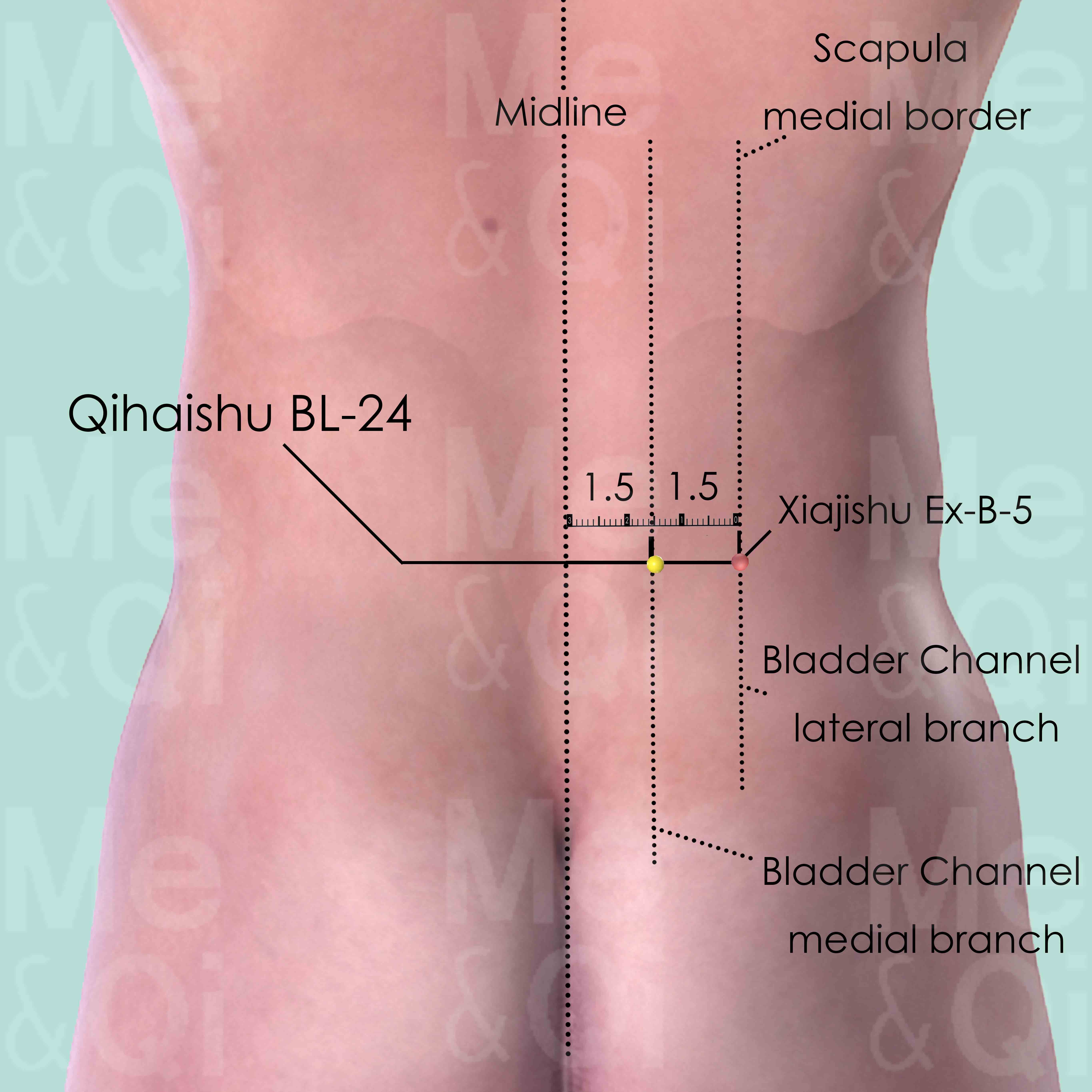
Qihaishu BL-24
1.5 cun lateral to the lower border of the spinous process of the 3rd lumber vertebra (L3).
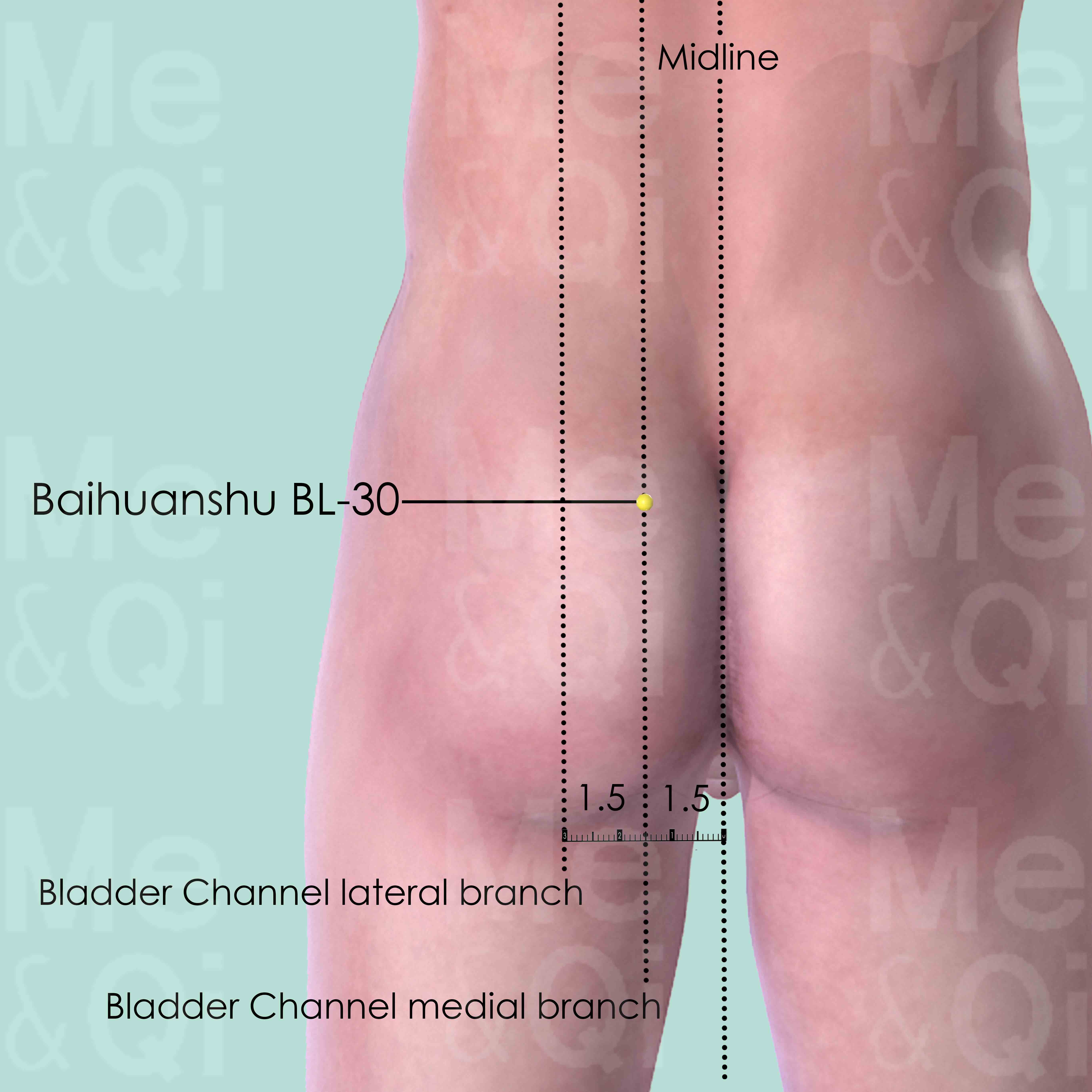
Baihuanshu BL-30
At the level of the 4th posterior sacral foramen, 1.5 cun lateral to the posterior midline.
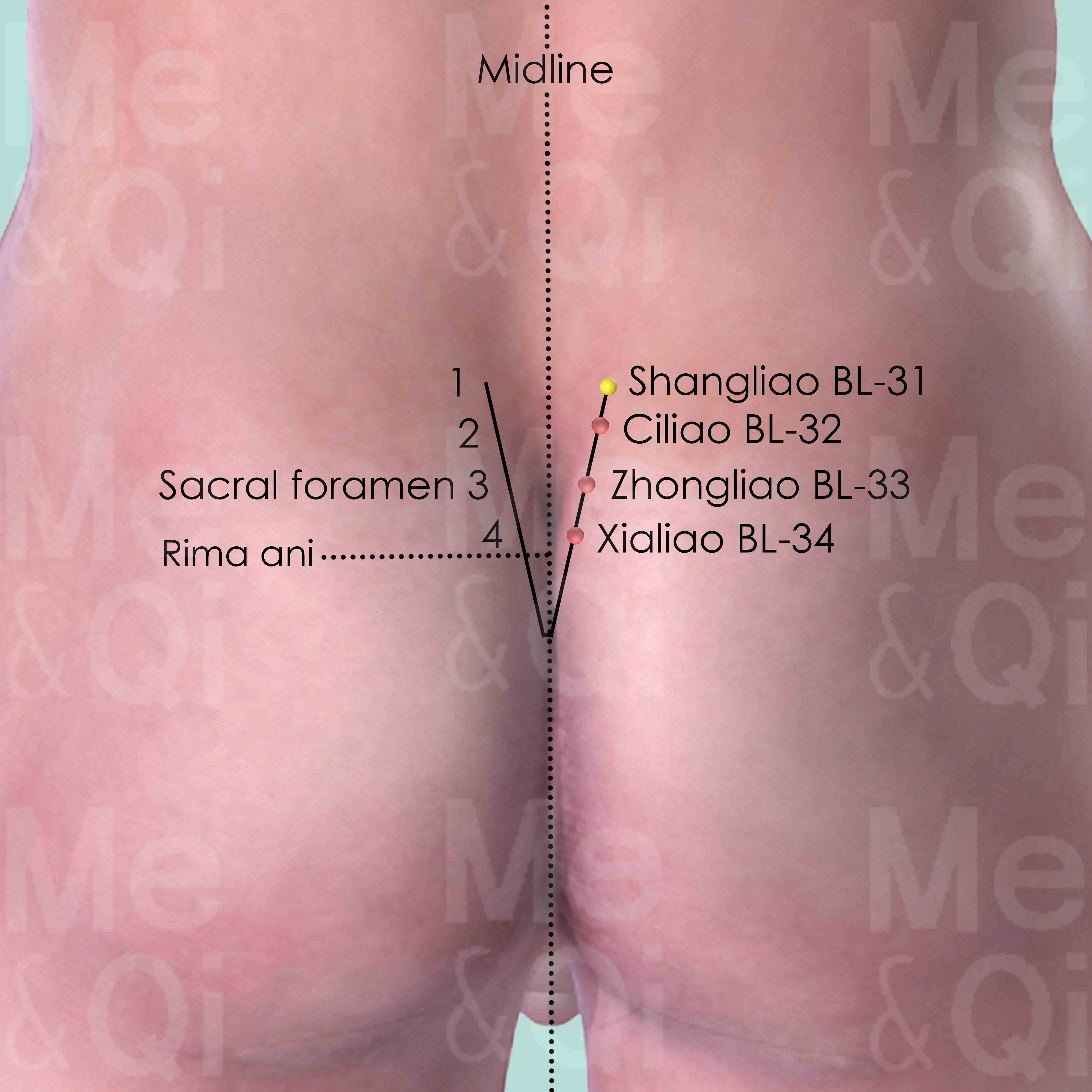
Shangliao BL-31
In the 1st posterior sacral foramen, about midway between the posterior superior iliac spine (PSIS) and the midline.
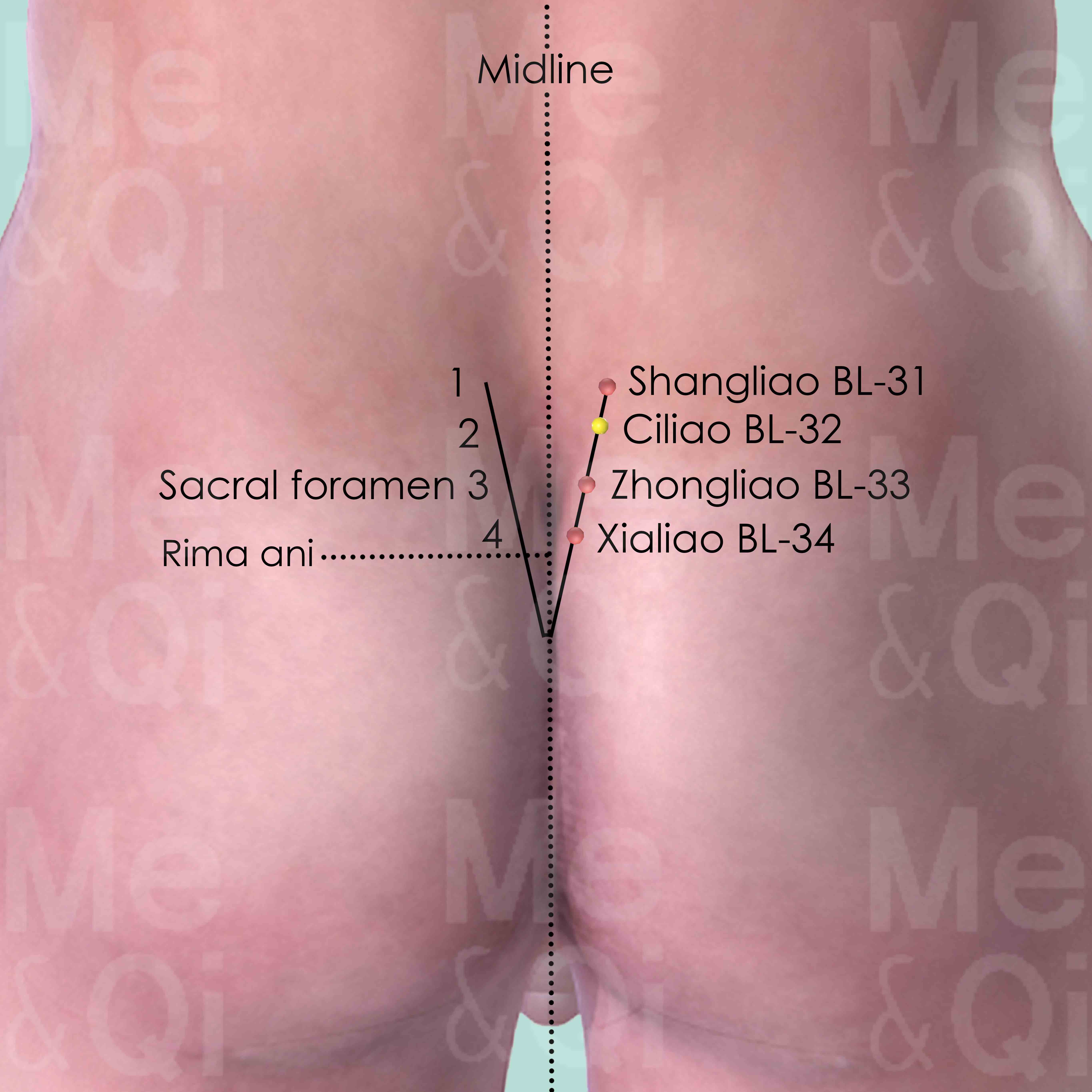
Ciliao BL-32
In the 2nd posterior sacral foramen, about midway between the posterior superior iliac spine (PSIS) and the midline.
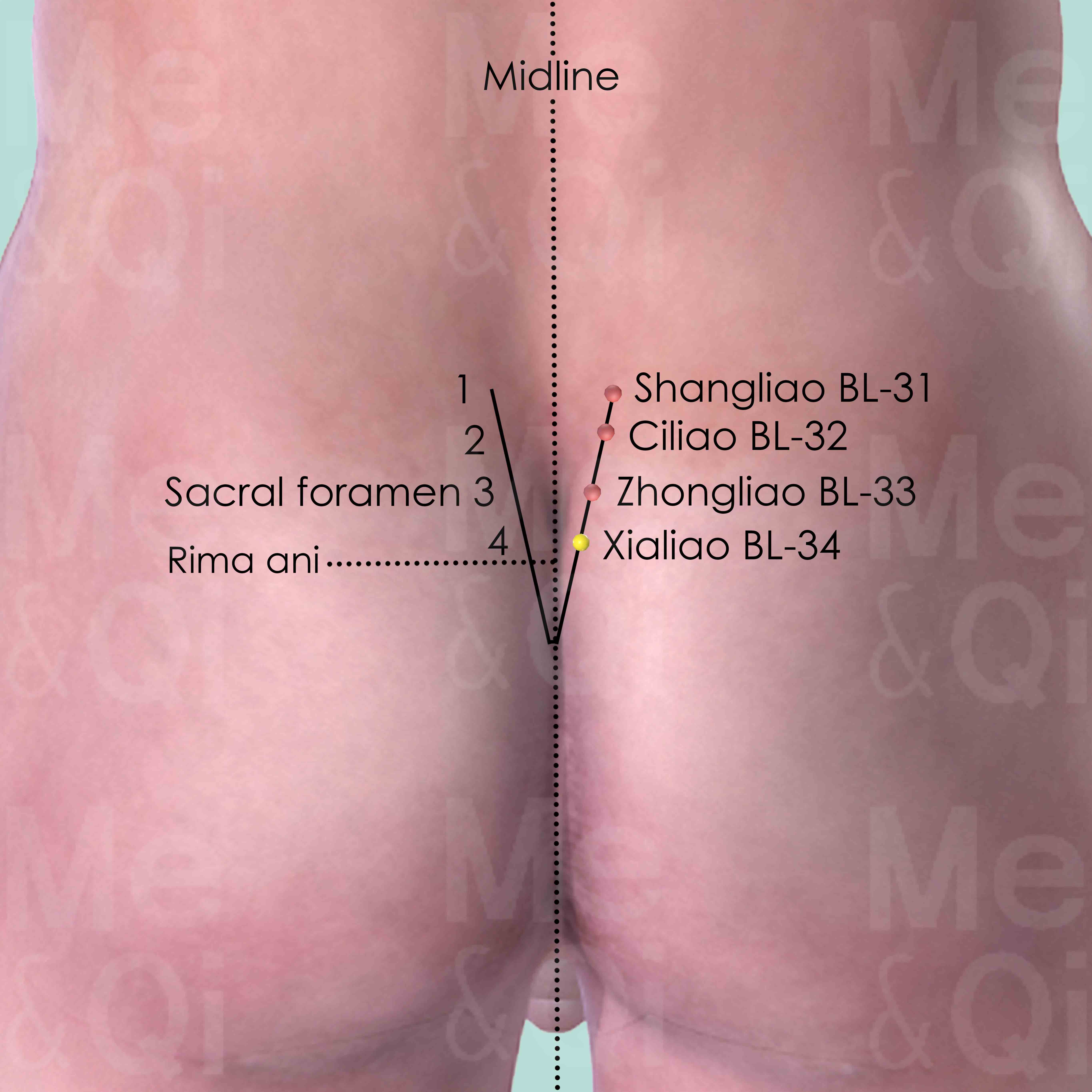
Xialiao BL-34
In the 4th posterior sacral foramen, between the posterior superior iliac spine and the midline.
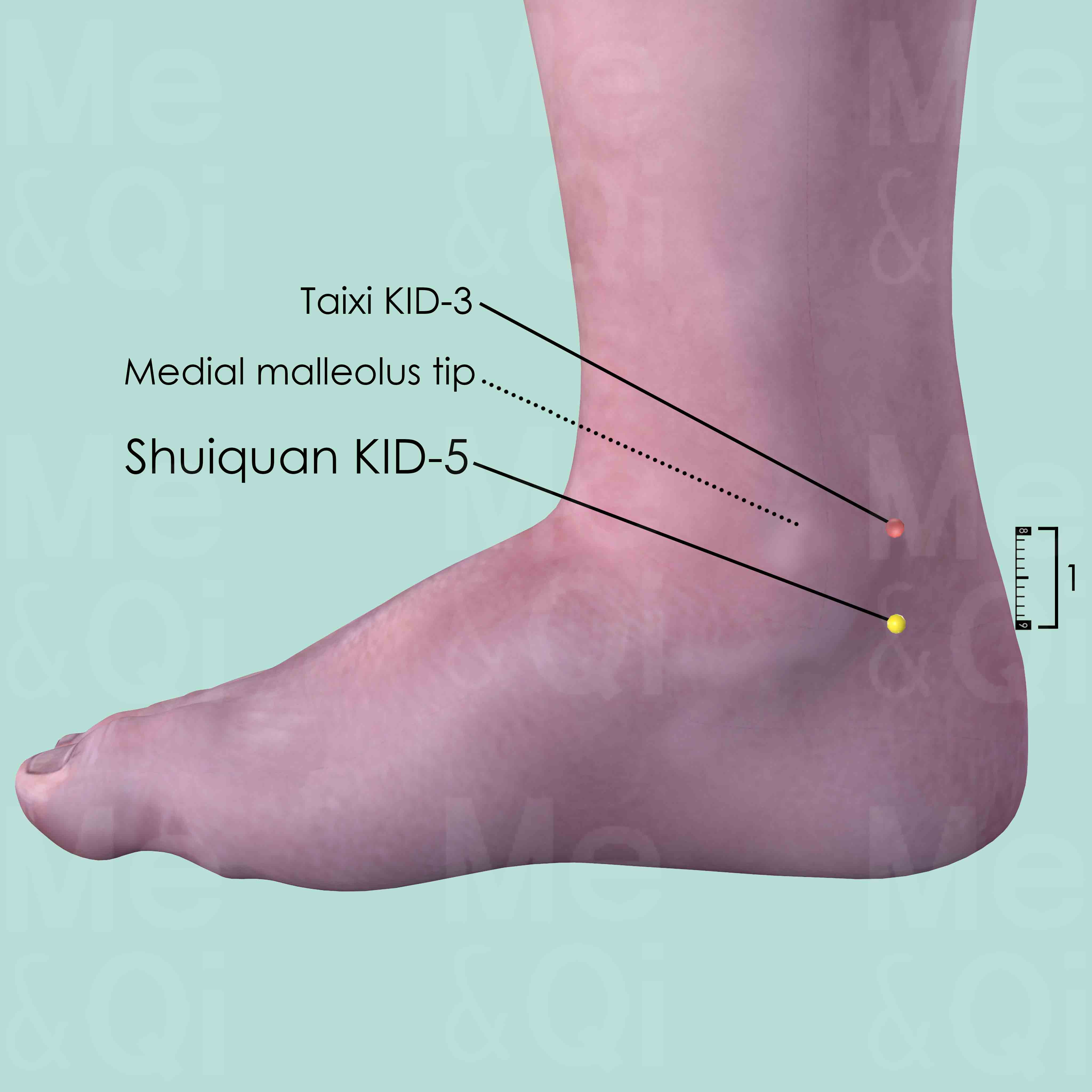
Shuiquan KID-5
1 cun directly below Taixi KID-3, in the depression over the joint space between the talus and calcaneus.
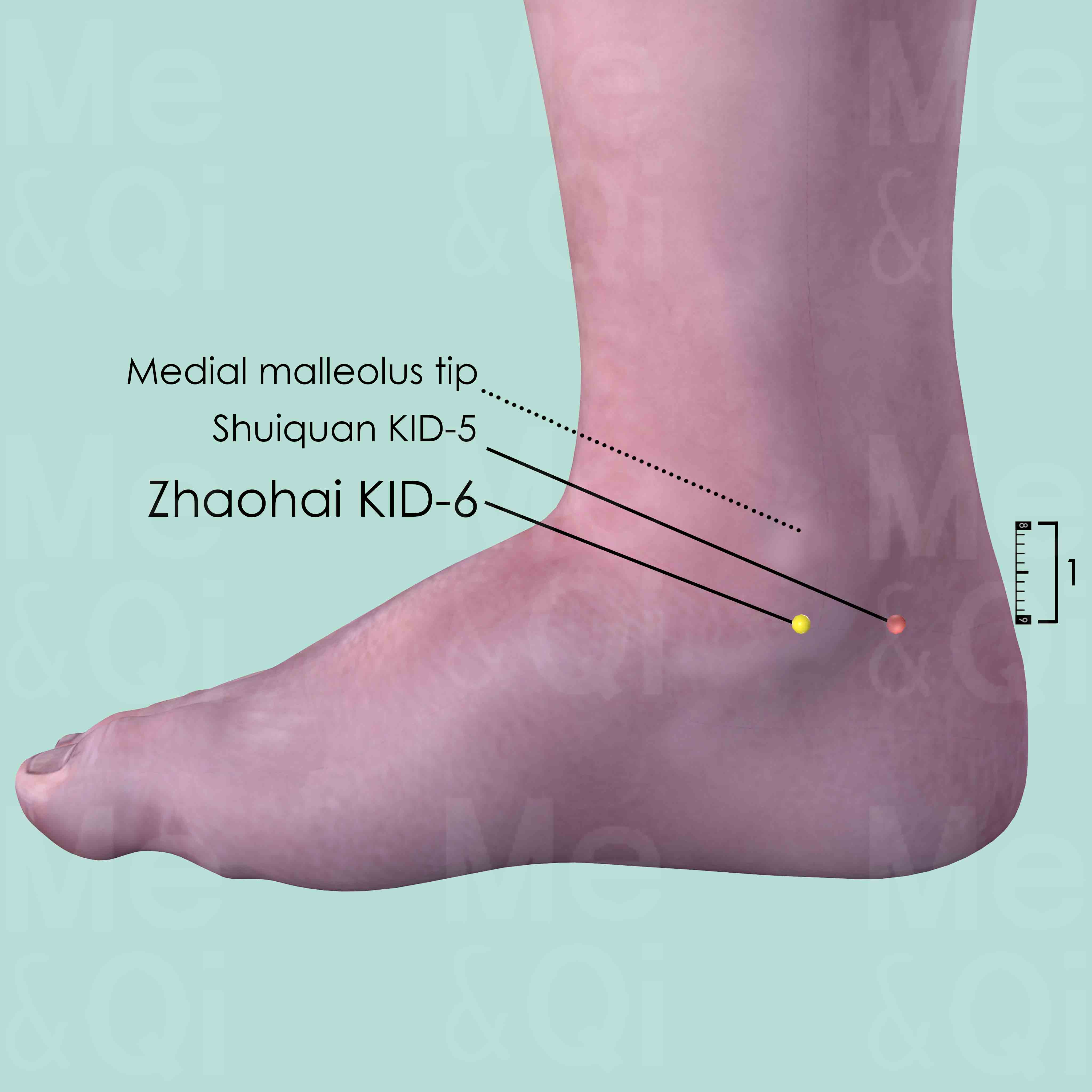
Zhaohai KID-6
Approximately 1 cun below the medial malleolus tip, over the joint space between the talus and the calcaneus.
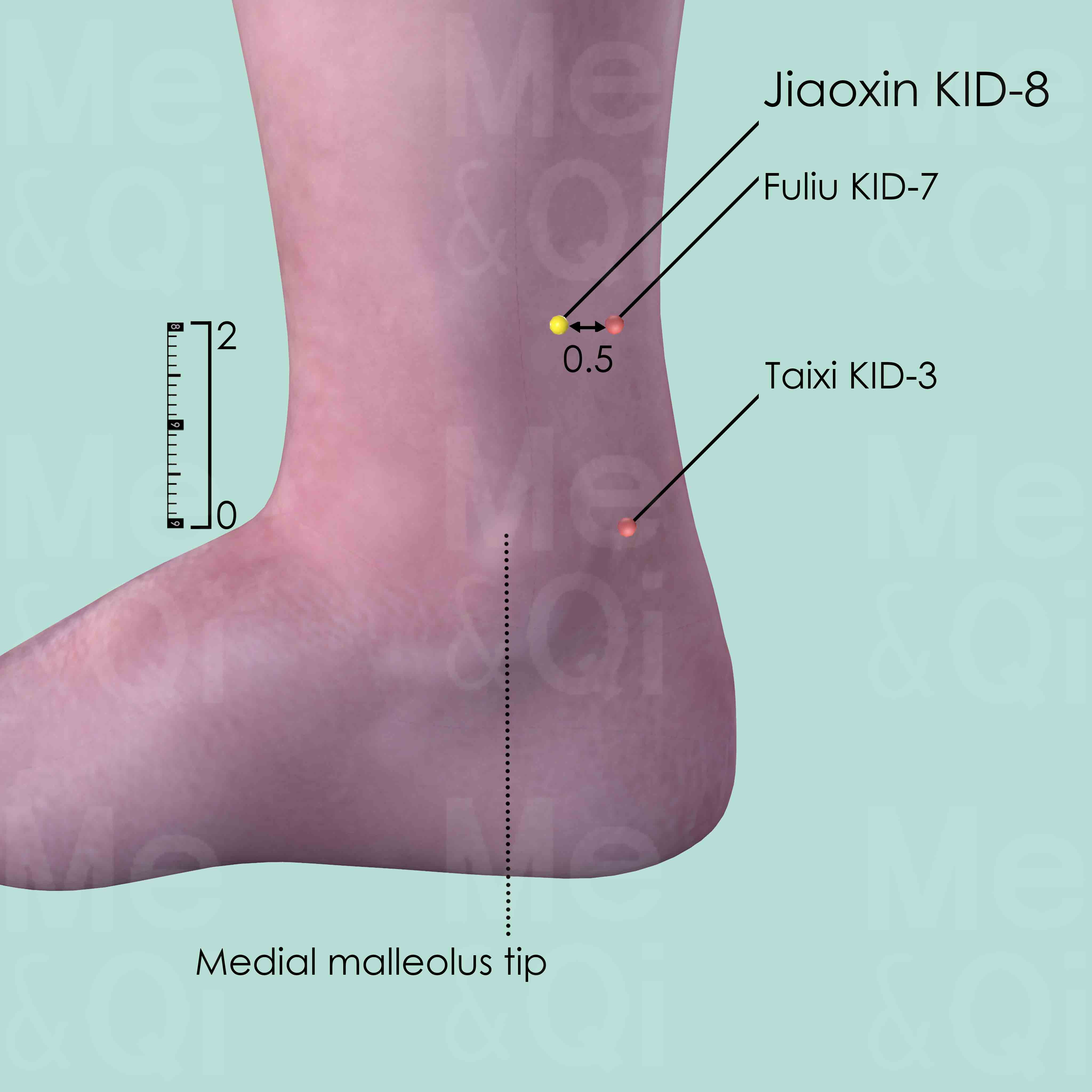
Jiaoxin KID-8
2 cun above Taixi KID-3, 0.5 cun anterior to Fuliu KID-7, posterior to the medial border of tibia.
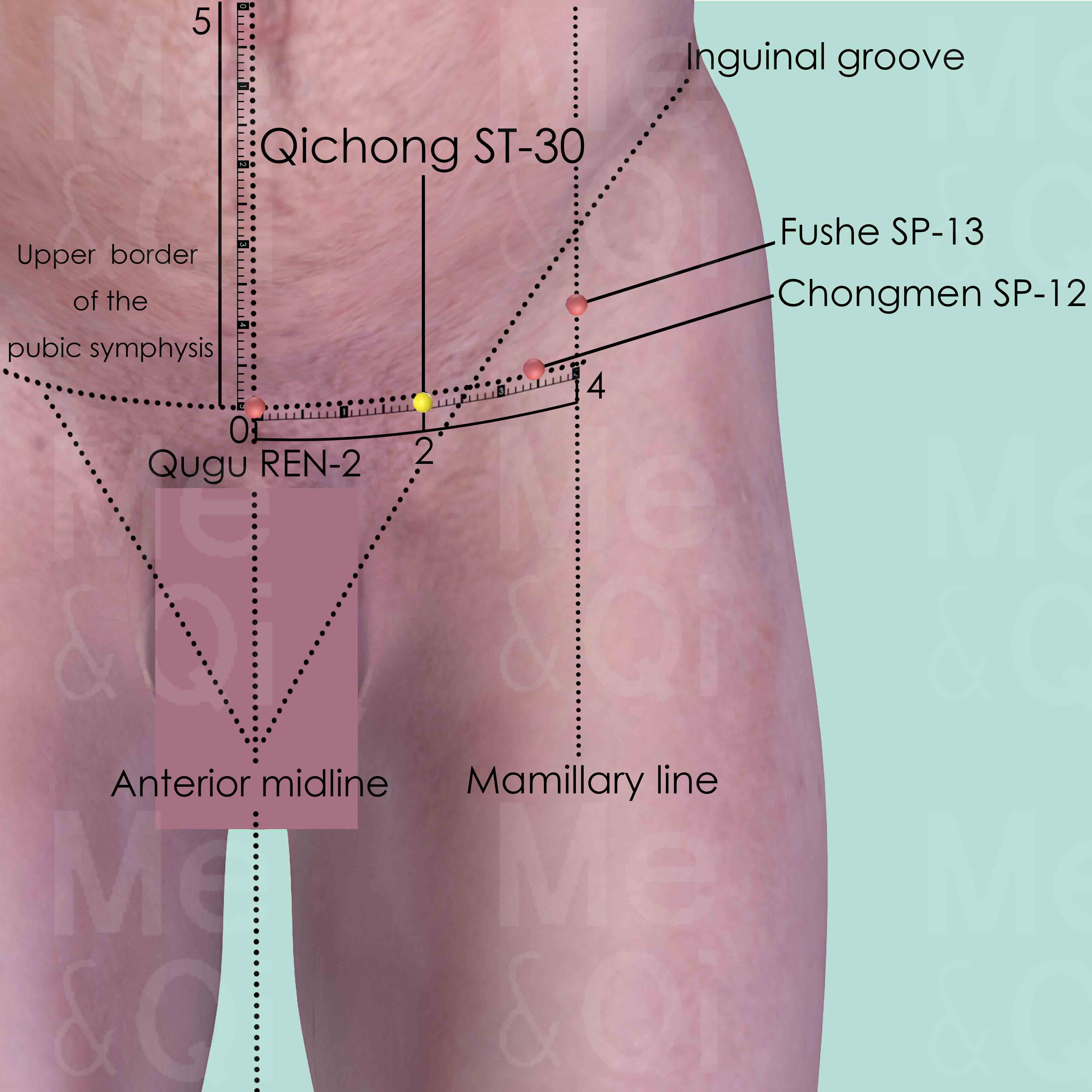
Qichong ST-30
5 cun below the umbilicus, 2 cun lateral to the anterior midline, superior to the inguinal groove, on the medial side of the femoral artery, nerve and vein.
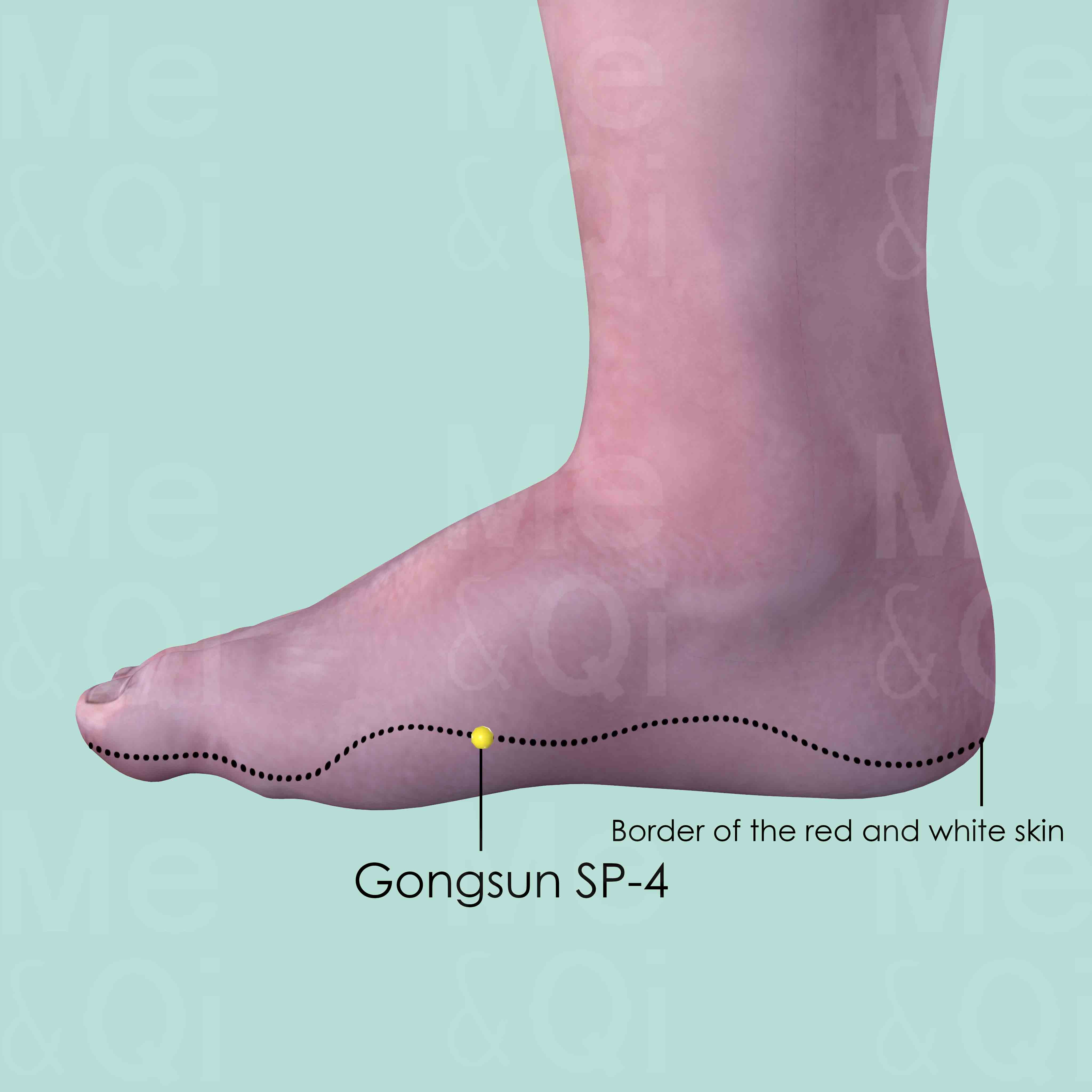
Gongsun SP-4
In the depression distal and inferior to the base of the 1st metatarsal bone, at the border of the red and white skin.
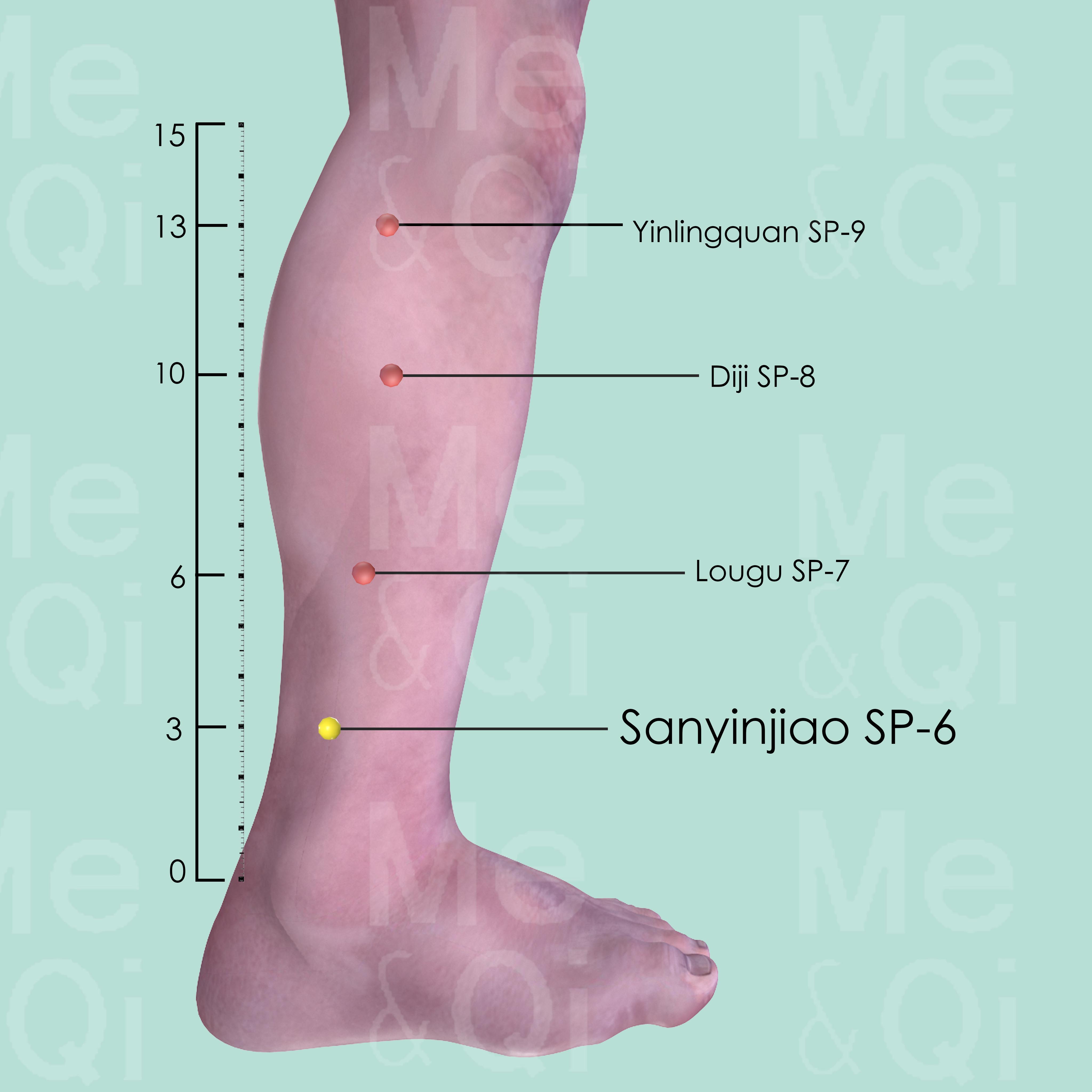
Sanyinjiao SP-6
3 cun directly above the tip of the medial malleolus, on the posterior border of the tibia, on the line drawn from the medial malleolus to Yinlingquan SP-9.
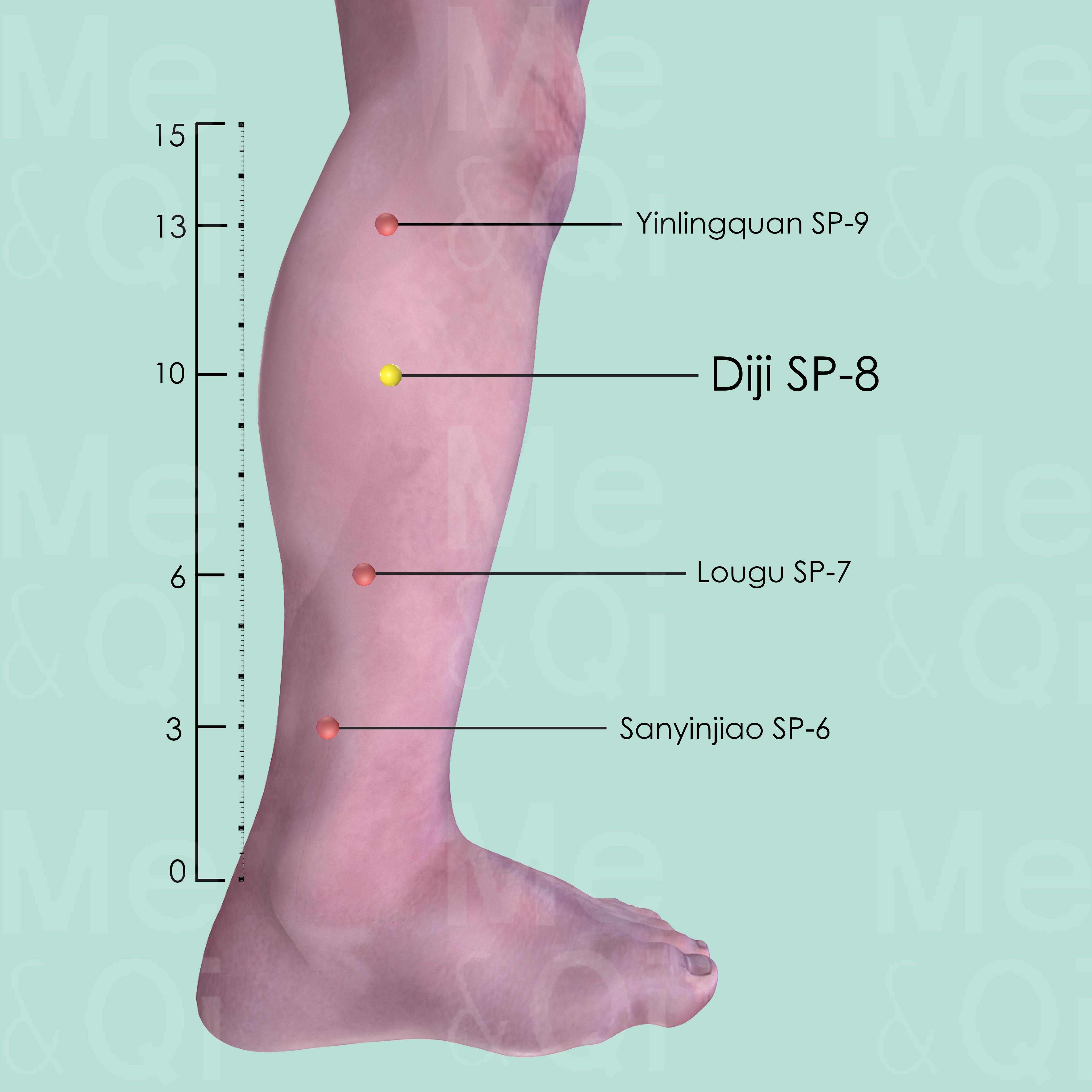
Diji SP-8
3 cun below the medial condyle of the tibia, on the line connecting Yinlingquan SP-9 and the the medial malleolus.
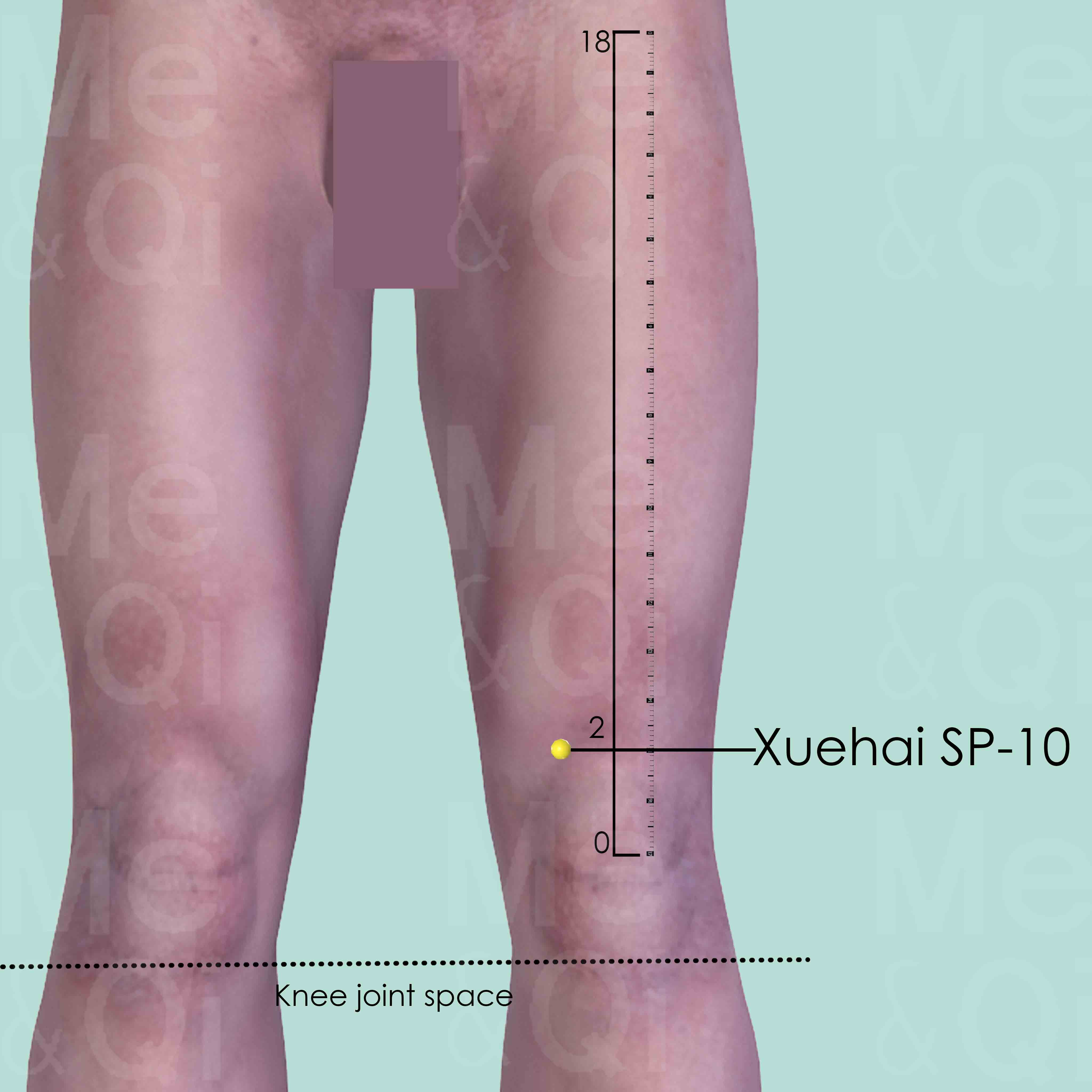
Xuehai SP-10
When knee is flexed, Xuehai SP-10 is 2 cun above the medial upper border of the patella, in a depression on the vastus medialis muscle.
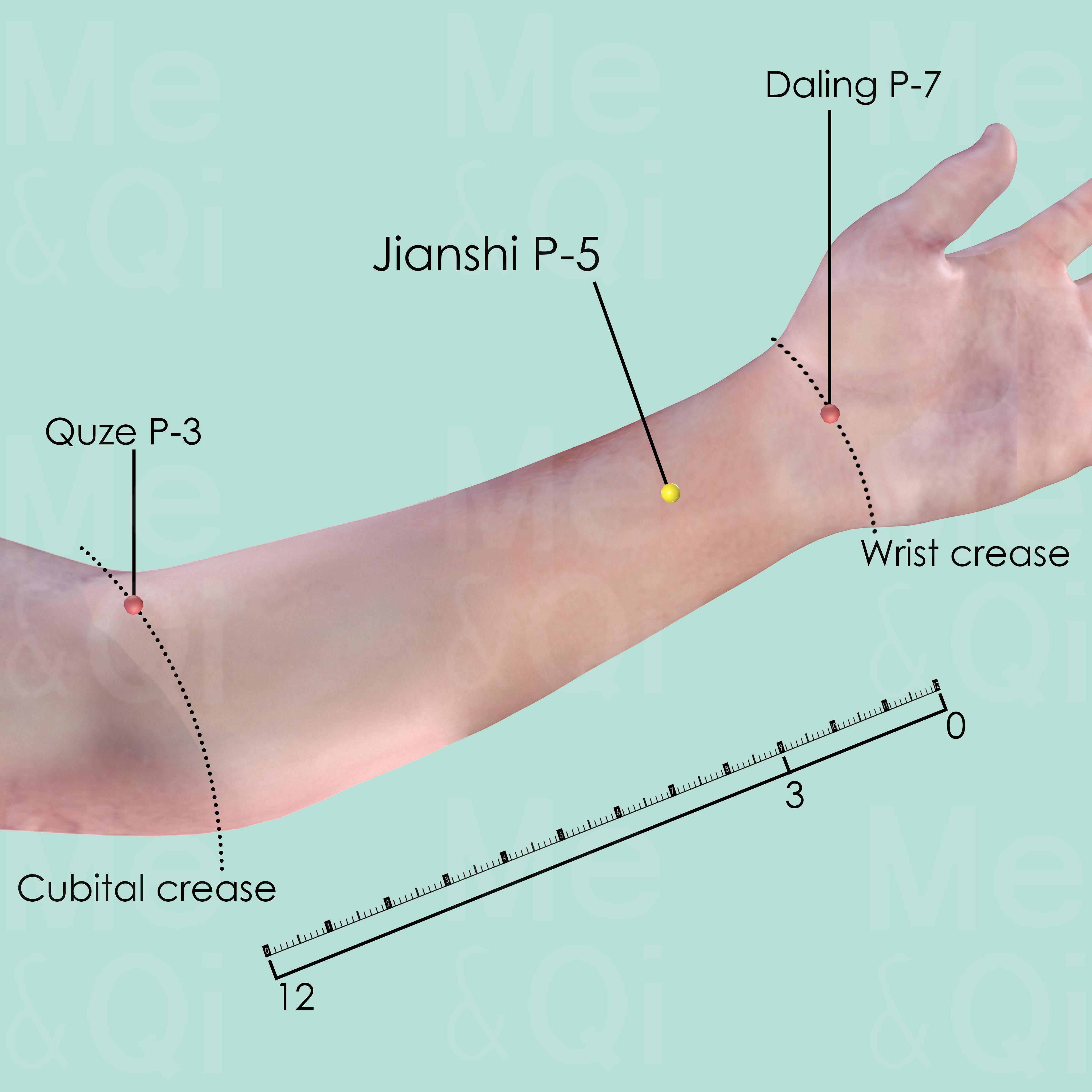
Jianshi P-5
3 cun above the transverse crease of the wrist, between the tendons of palmaris longus and flexor carpi radialis muscle.
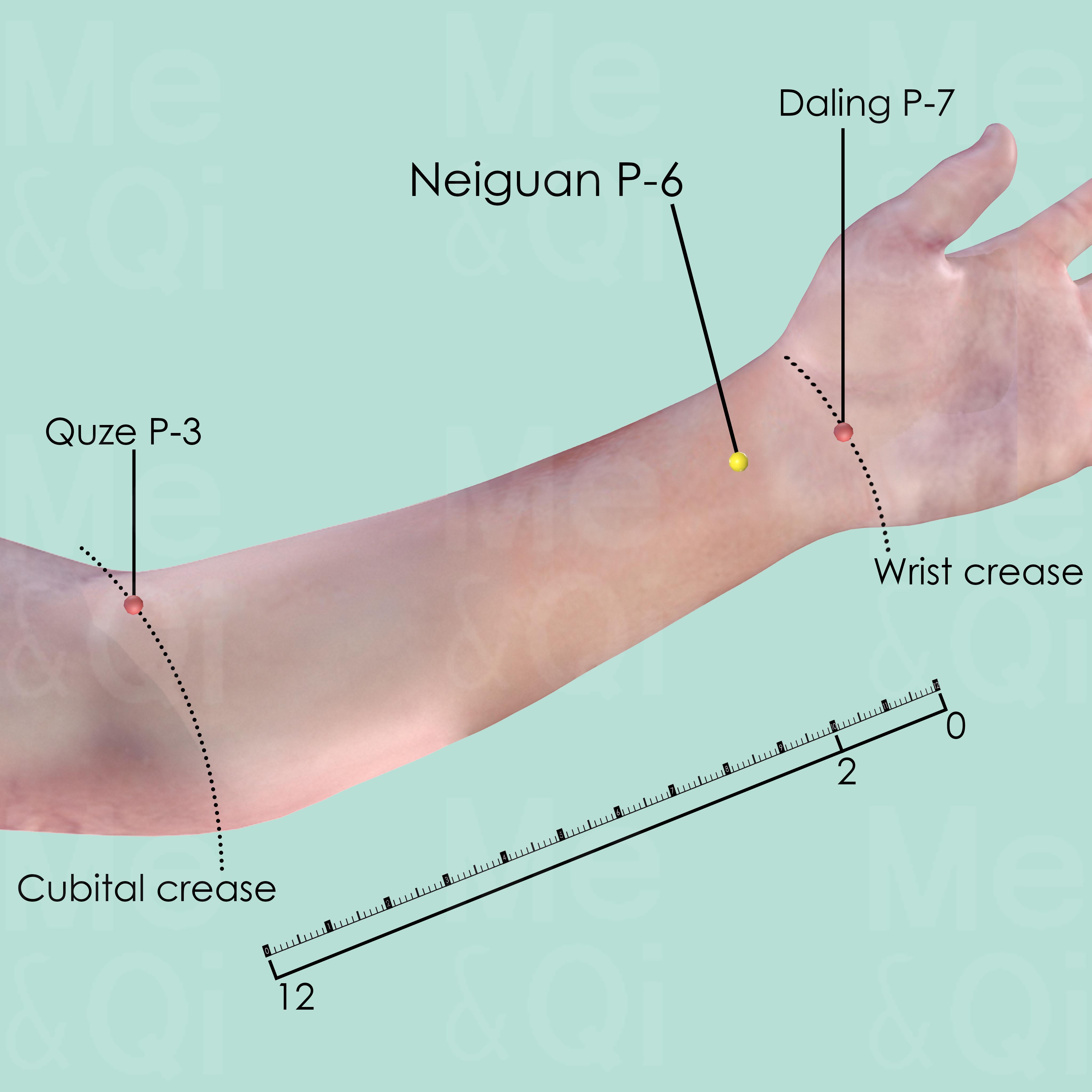
Neiguan P-6
2 cun above Daling P-7 on the transverse crease of the wrist, between the tendons of palmaris longus and flexor carpi radialis muscle.
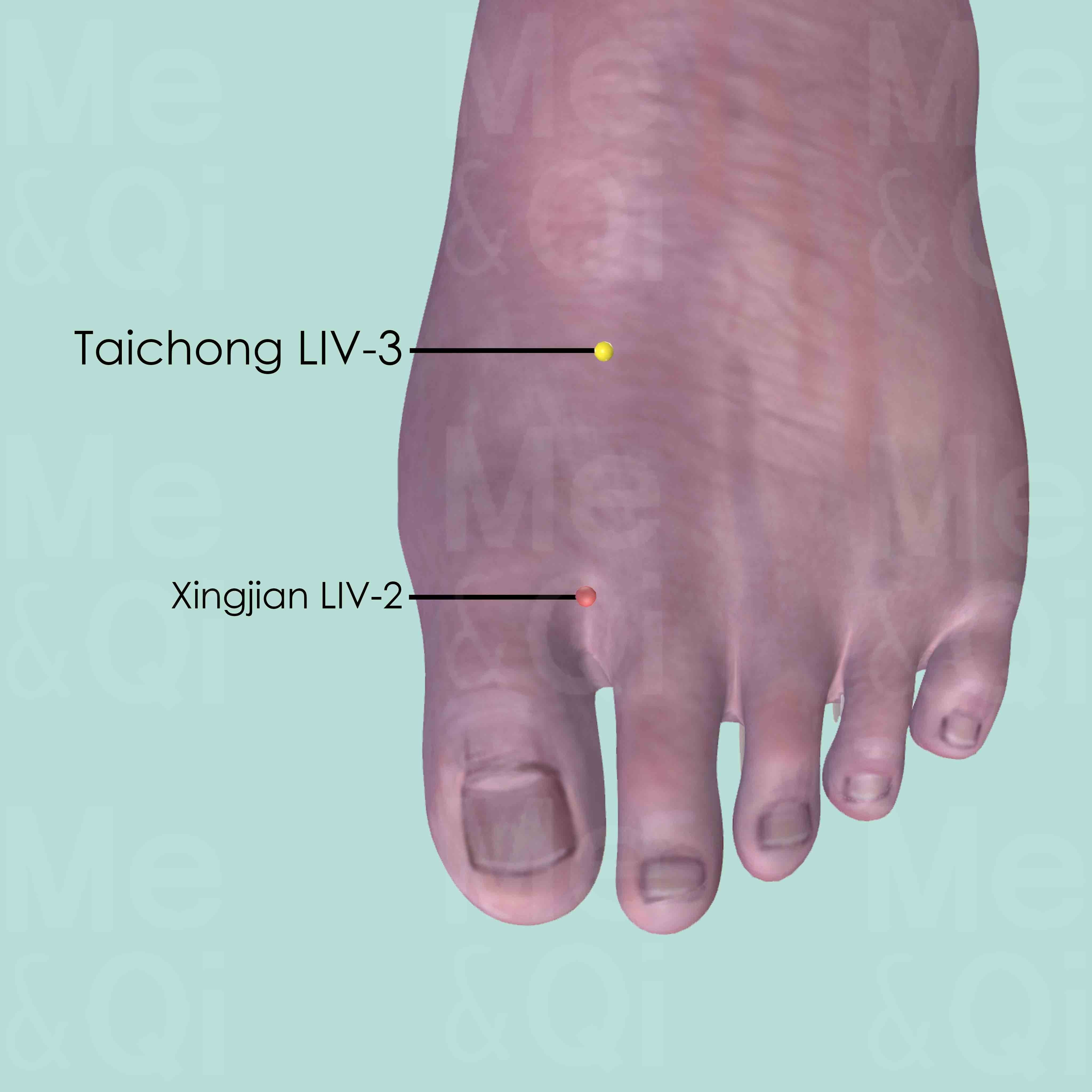
Taichong LIV-3
On the dorsum of the foot, between the 1st and 2nd metatarsal bones, in the depression proximal to the metatarsophalangeal joints and the proximal angle between the two bones.
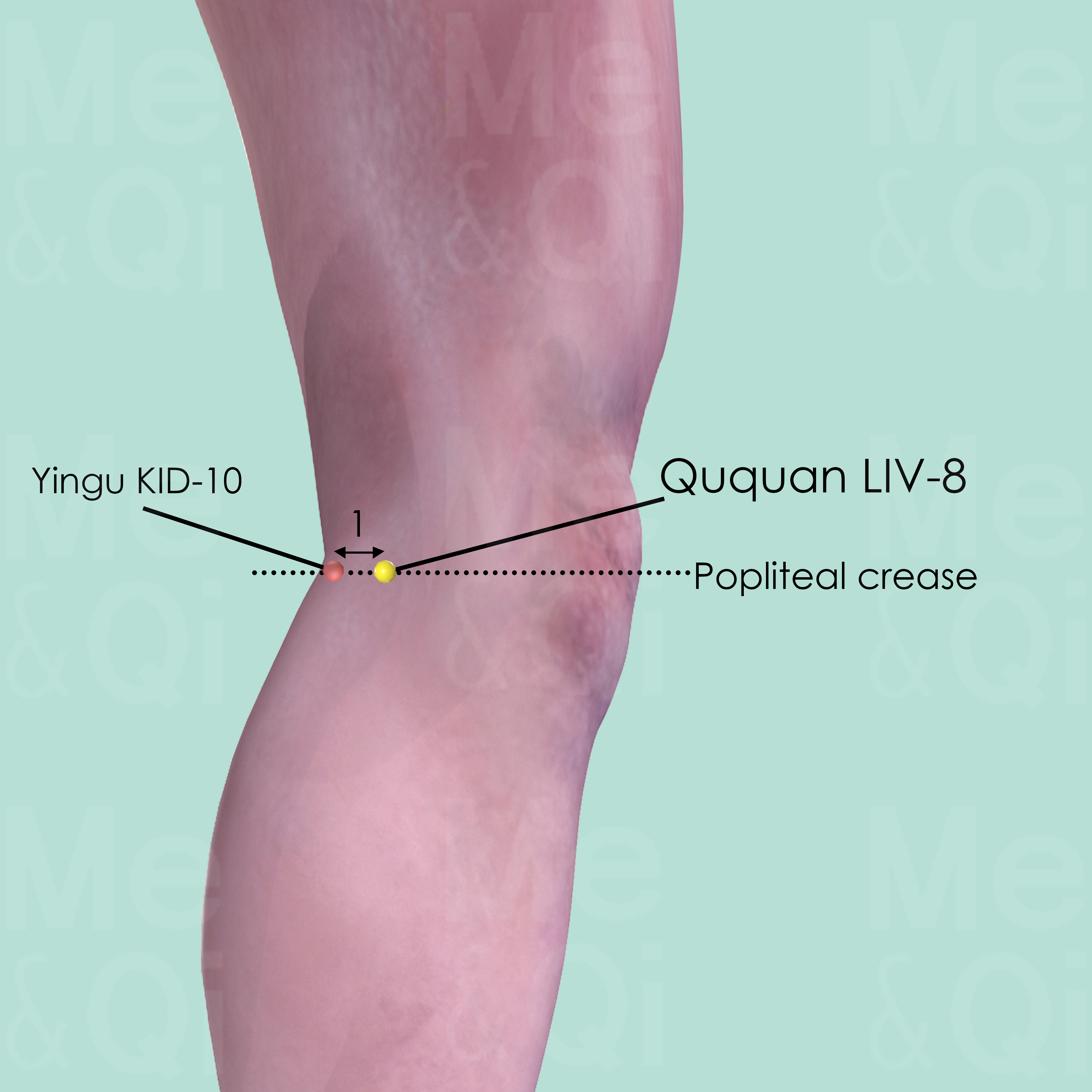
Ququan LIV-8
On the medial aspect of the knee join. Flex the knee and locate the point above the medial end of the popliteal crease, posterior to the medial condyle of the tibia, on the anterior border of the insertion of semimembranosus and semitendinosus muscle, about 1 cun anterior to Yingu KID-10.
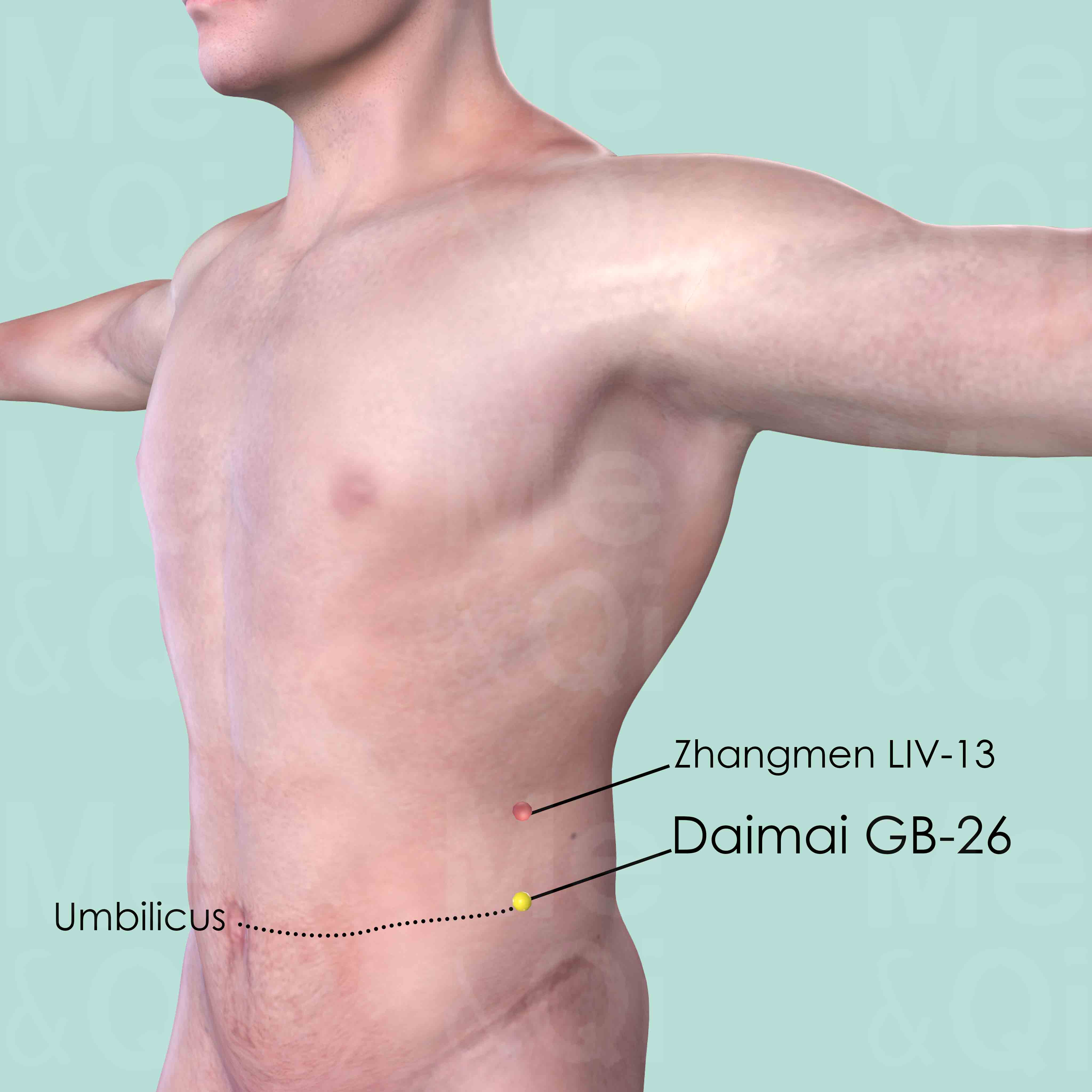
Daimai GB-26
Level with the umbilicus, directly below Zhangmen LIV-13 which is on the free end of the 11th rib.

